Francesca and Henk-Jan's Backpacking Trip!
Sunday, May 16, 2010
Manila: Something Simple, Decorated to Death!
Our plane touched down in Manila, the Philippines on May 12th at around 12:00 PM and readied ourselves for a new country to explore! While we were at the airport that morning, we were informed that we MUST have a return flight to go through customs and thus had to purchase one on the spot. I had read online that this policy isn’t really enforced by customs themselves, but the airlines obviously are motivated to do so themselves. We purchased a cheap return flight, and then watched Gossip Girl while passing the 2 hours on the plane.
Anyways, Henk and I took a metered cab to Friendly’s Guesthouse, where we planned to stay a few days to plan our time in the country and get our bearings. We booked into a small double room and proceeded to whip out the Lonely Planet, various magazines and brochures, and with the wealth of information on the internet, began to plan our trip. We ordered in food (pizza for myself, spaghetti for Henk) and worked on our schedule for the upcoming weeks. However, we quickly ran into trouble.
There are over 7,000 islands which comprise the Philippines … specifically 7,107 of them. Obviously this leads to a lot of confusion when planning where to go and how long to stay. I had a particularly difficult time learning the ‘map’ of the Philippines; where exactly the different cities were, the various names and where the ‘to do’ activities were within said locations. Thankfully, Henk thought to ask Benji, the owner of Friendly’s, for some advice on where to spend our time. He drew out a little timeline for us, rattling off names of cities and helpful tips on which to visit and in what order. BIG help to get us started. I finally finished making my personal ‘self help’ guide of the important Lonely Planet information and Henk found details of tours online. More confident about what our plan was, we took the next couple days to relax in the many malls of Manila.
The morning of the 13th, we headed around the corner to Robinson’s Mall, and were in awe almost immediately upon entering the mall. There were food stalls EVERYWHERE! Filipinos love to eat, probably even more than Americans, and we saw row after row of restaurants and snack stalls. I couldn’t even see the shops through the food! Everything from New Orleans gumbo complete with waiters and waitresses wearing colorful Mardi Gras hats to Middle Eastern dishes, classic American, Thai, Japanese, Italian, Chinese, even Mongolian! My favorite was a place that called itself ‘The House That Fried Chicken Built!’ The snacks and fast food were even more impressive: mini empanadas, make-your-own pitas, doughnuts and cakes galore, and eateries dedicated to dish combinations such as ‘Chicken and Waffles.’
The last of these delicacies is what we feasted on that afternoon, well I did, while Henk ordered a large salad complete with waffle croutons and ‘won’ two free fruit cups for his health efforts. I don’t know if it is a wise concept to reward healthy eating with more food, but Henk was happy! We went over some of our trip ideas while eating, and then put them aside for some rest time watching Iron Man 2 in the movie theater we found on an upper floor. I think it has been half a year since we’ve been out to the movies! We also decided to send another box home to Florida via DHL with 10 kg of stuff… it’s been a difficult choice to send things home; Henk does the carrying of our large bags and it becomes tiresome to lug around so much, but it costs a bundle to send even just a little bit of stuff home. And there is always the risk of losing something…
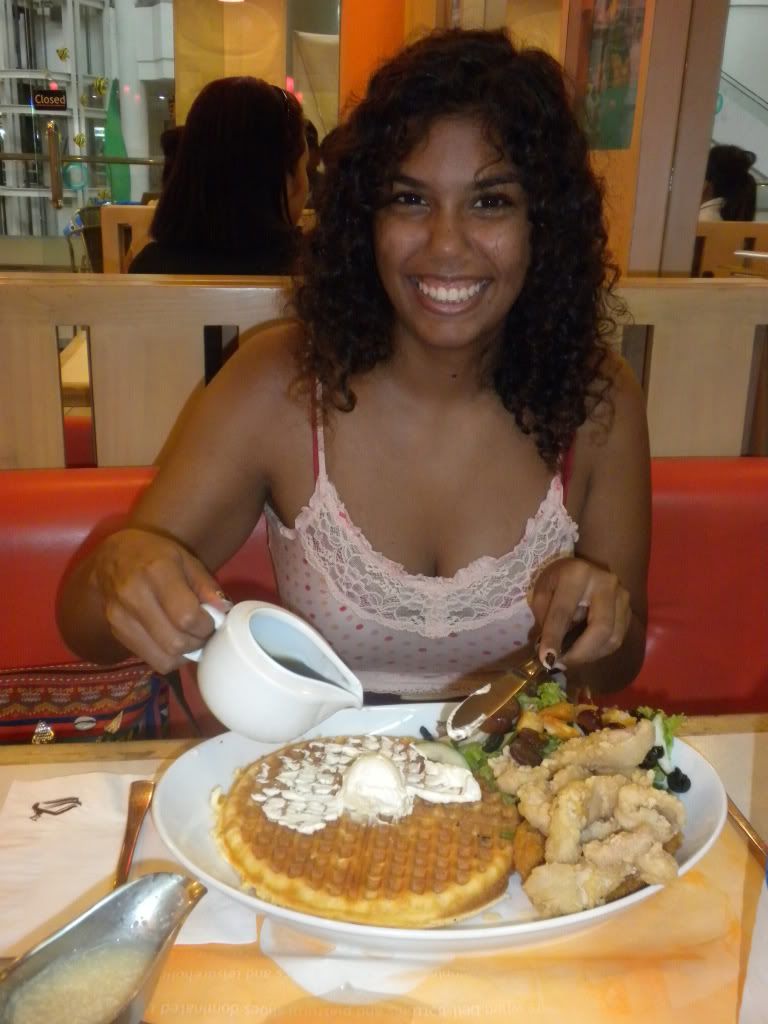
The 14th was spent planning our trip, packing up our box, and getting a manicure/pedicure for myself. (It had been ages since I last had one!) We ate at the ‘House That Fried Chicken Built’ which is actually called Max’s, ordering chicken for me and an asparagus/tofu dish for Henk. Since we realized after packing our box that we still had an extra 2 kg of weight, we rushed back to the hostel and grabbed a ton more stuff to try and fit in. We did it… exactly 10 kg of weight! We paid for it, and set off.
We had to go to bed early that night because we had to get up to meet a group at 4:00 AM for a tour to the 2010 Pahiyas Festival in Lucban. Initially we were told Lucban from Manila was about a 2.5-3 hour drive. WOW, was that wrong! Anyways, we met our group at the buses outside of the Peninsula Hotel and were assigned to Bus #2. We settled in for the long drive, watching a string of movies along the way. However, after watching all 3 of the Resident Evil trilogy plus two other movies we realized we had been driving for QUITE a long time. Yes, the traffic was horrible, but we had spent the first hour of our ‘tour’ sitting in the parking lot waiting for additional people to arrive.
Thus we left an hour later, hitting the horrible morning rush. Henk and I grabbed breakfast at Jollibee – which was not too fantastic – and continued sitting in the bus. It wasn’t until 12:00 PM that we made it to the festival. This doesn’t seem too late, but mind you we were 4 hours behind schedule and had missed one of the churches/shrines we were supposed to see. At first we thought the lateness might be something the locals were used to, but when we sat down to eat we heard the complaints start! We walked until reaching a large buffet where we tried to sift through the gruesome food there to find something edible. Or decently edible. It all looked pretty disgusting to me… every single time we encounter a buffet on this trip, I end up sick. I stuck with the dessert table, while Henk chanced the buffet only to later complain through the afternoon about an upset stomach.
It wasn’t until around 2:00 PM that we actually got to look at the festival. It was jam-packed with people and difficult to walk through the streets but we managed. We were handed a piece of paper that explained a bit more about the festival we were witnessing, the important parts I’ll copy here:
“The Lucban San Isidro Pahiyas Festival is one of the most colorful in the Philippines… the main attraction are the houses decorated with ‘kiping,’ a rice-wafer molded like a leaf and hung in chandeliers and other creations, shapes and sizes. The festival is a form of thanksgiving to God (originally a nature/animist festival, now Christianized) through San Isidro, the patron saint of farmers for the bountiful harvest, thus most of the houses are adorned with fruit and vegetables as an offering.”
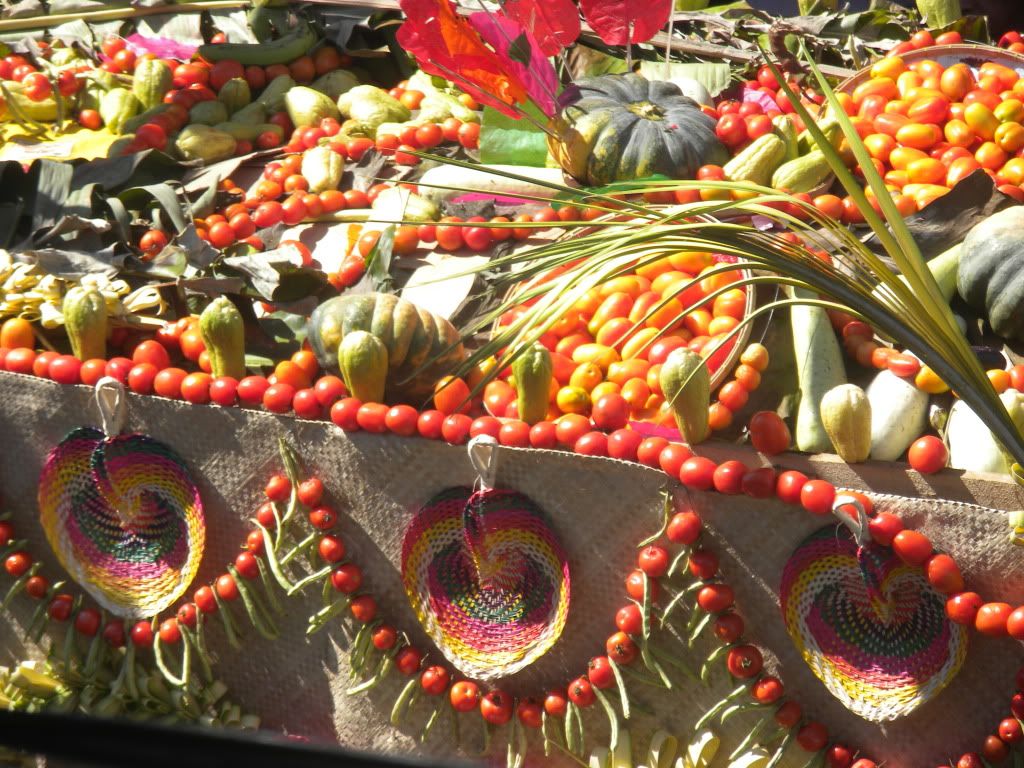
The houses looked really cool: covered in kiping and other natural decorations such as vegetables, dried and painted coconut shells, fruit, leaves, rice stalks, grasses – some even had ‘paintings’ made out of colorful seeds/beans or what appeared to be crushed kiping. Others had make-shift animals such as birds crafted out of hanging vegetables, or pigs created from natural fibers. Some buildings were decorated with colorful organic hats and/or fans. Henk and I noticed that many of the houses had numbered ‘tags’ on them. The houses were going to be judged on their decorations! Fun… later we walked around viewing the winners. We were blow away by the top two winners; try and figure out which two they are! (If you zoom on some of the pictures, their ‘winner’s place’ banner might show.)
We also witnessed the festival parade while in Lucban. While there was plenty of kiping-covered floats advertising corporations or local sponsors (even a few people with product names painted directly on their bodies) the parade was still interesting to watch for the unique ‘fashion show.’ Known as “parikitan,” this parade is a showcase of costumes made of organic materials. The colorful clothing resemble the house decorations, but more refined. Following the outfits were a few water buffalo, painted for the celebration.
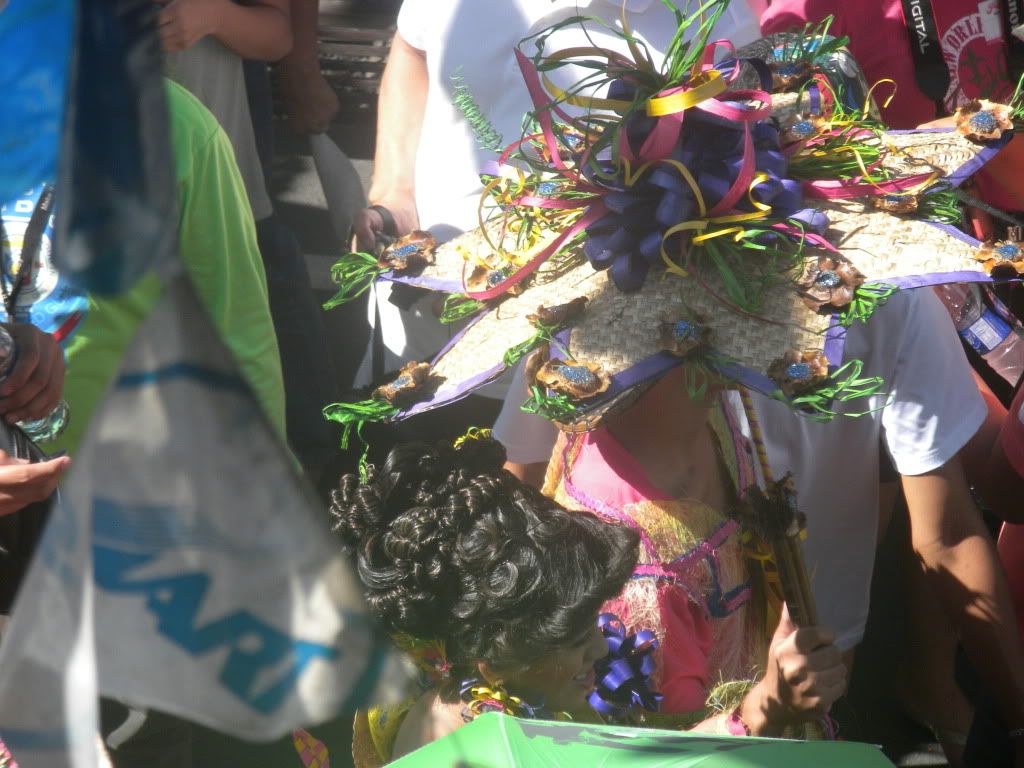
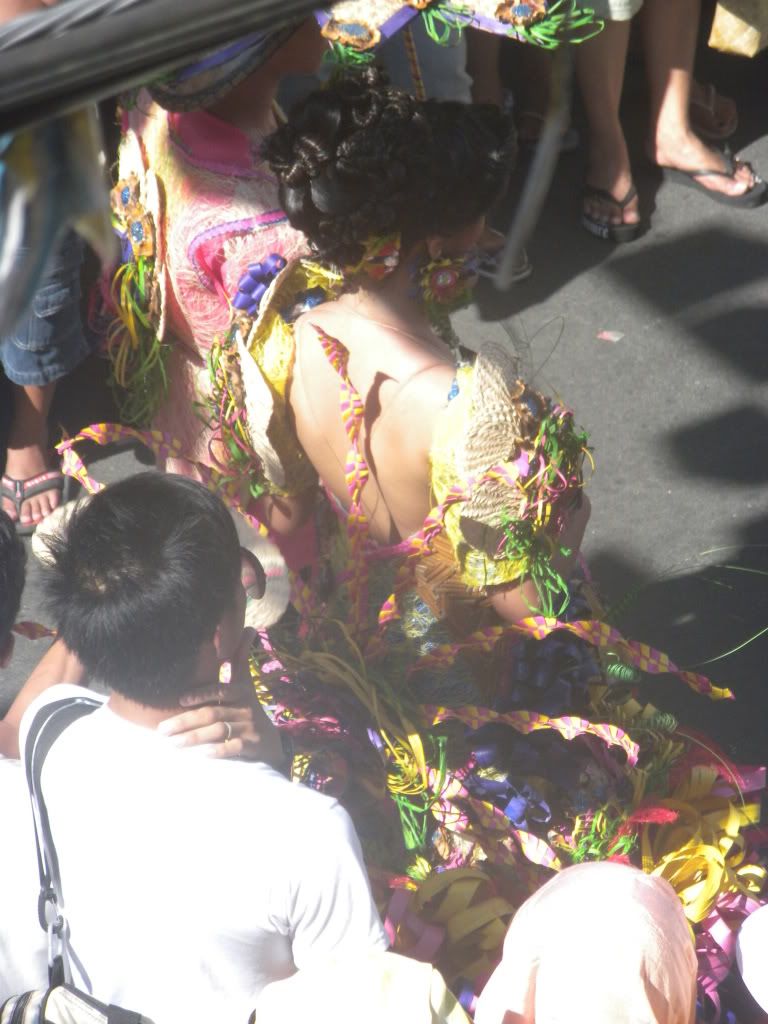
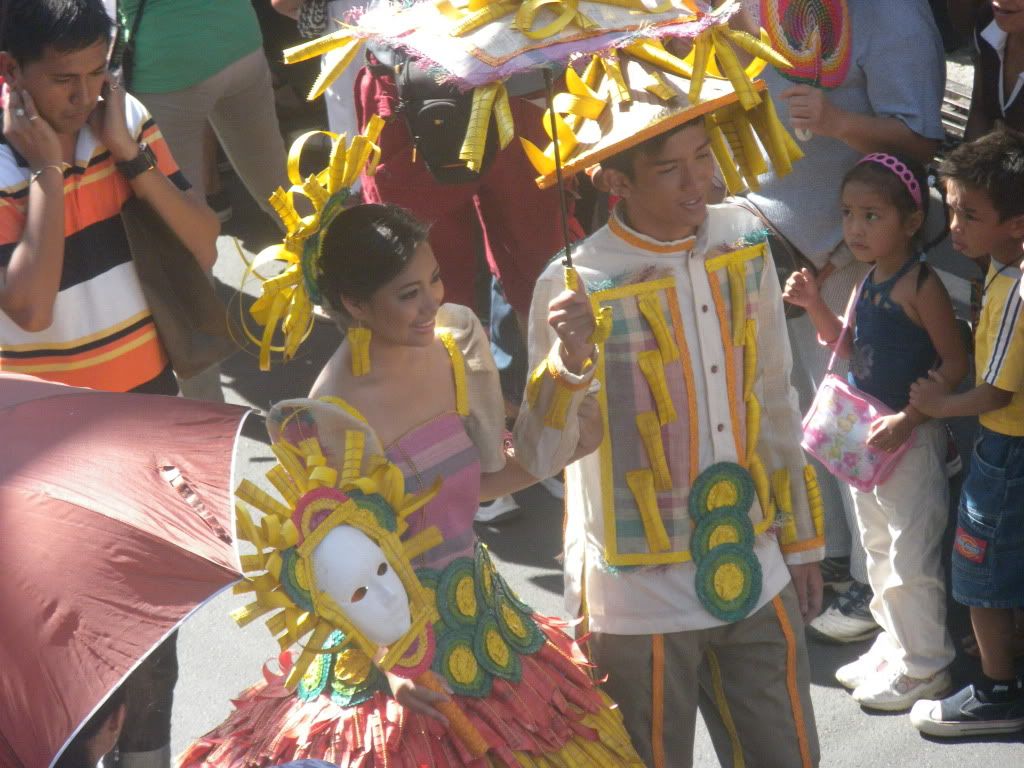
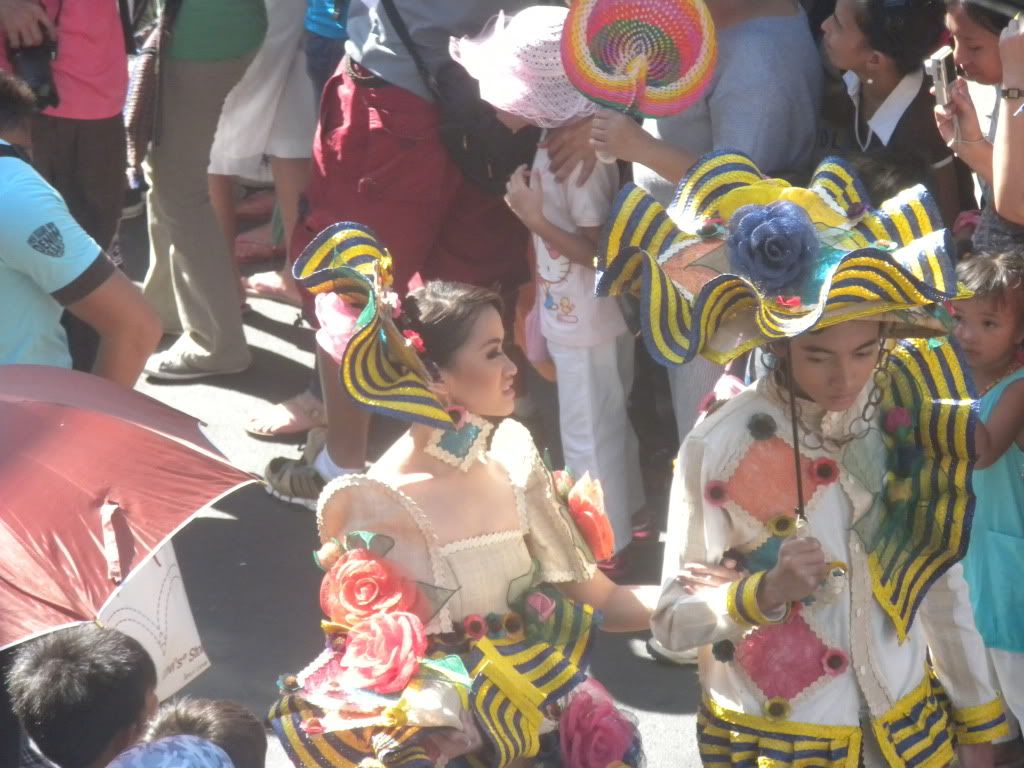
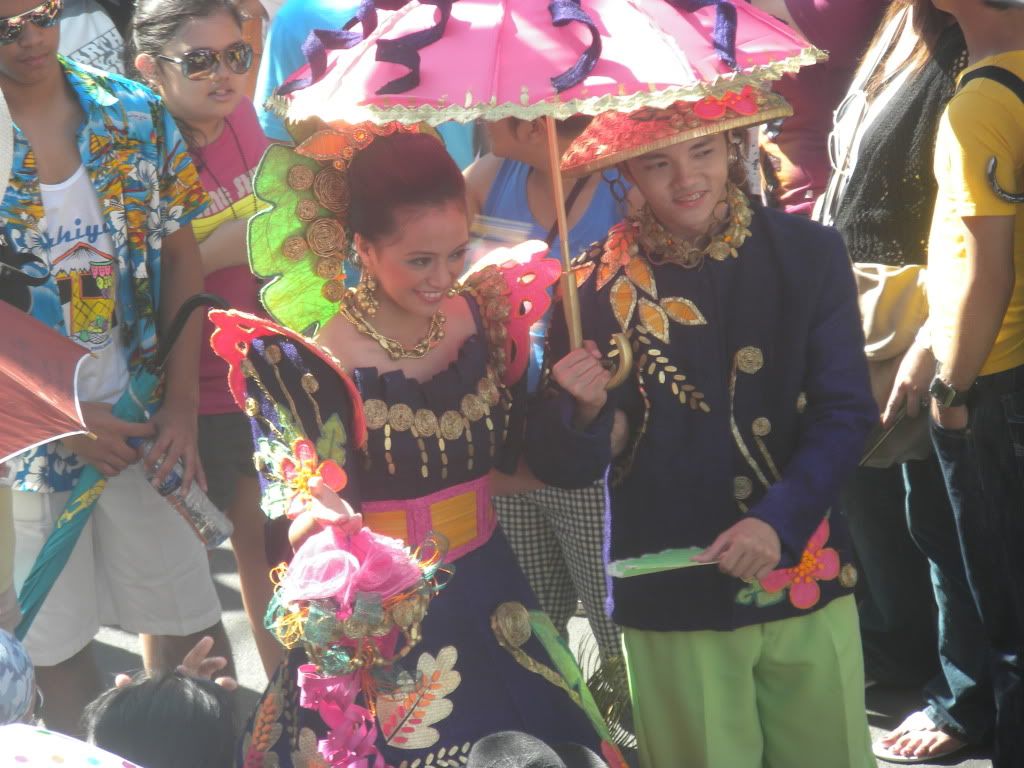
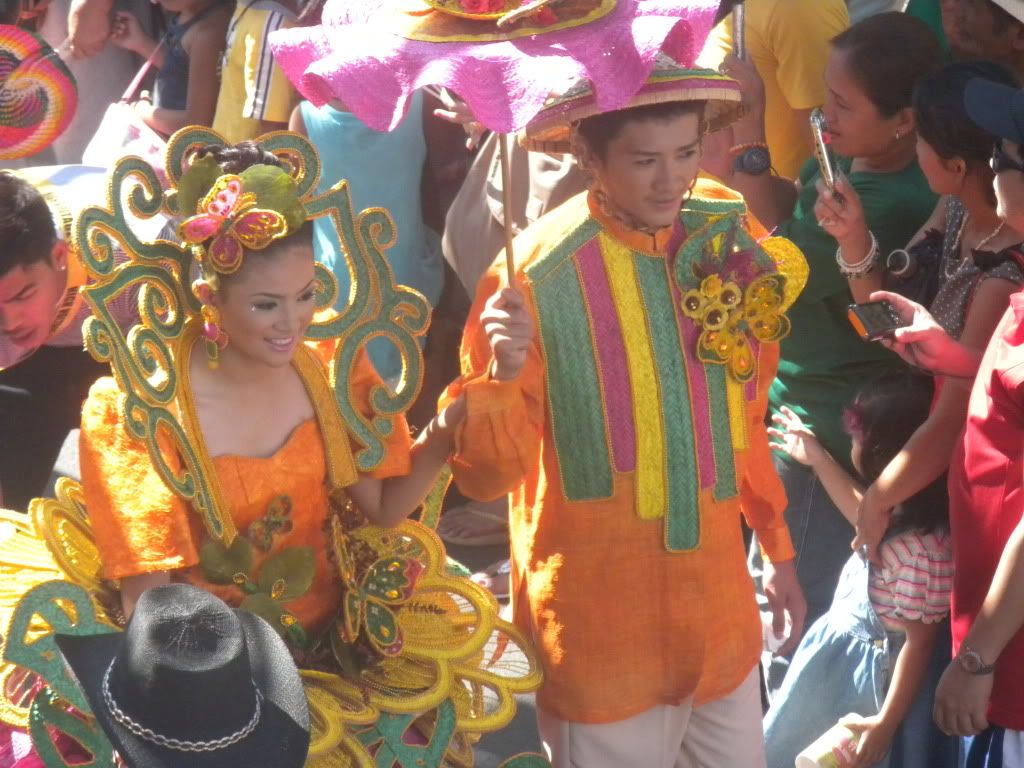
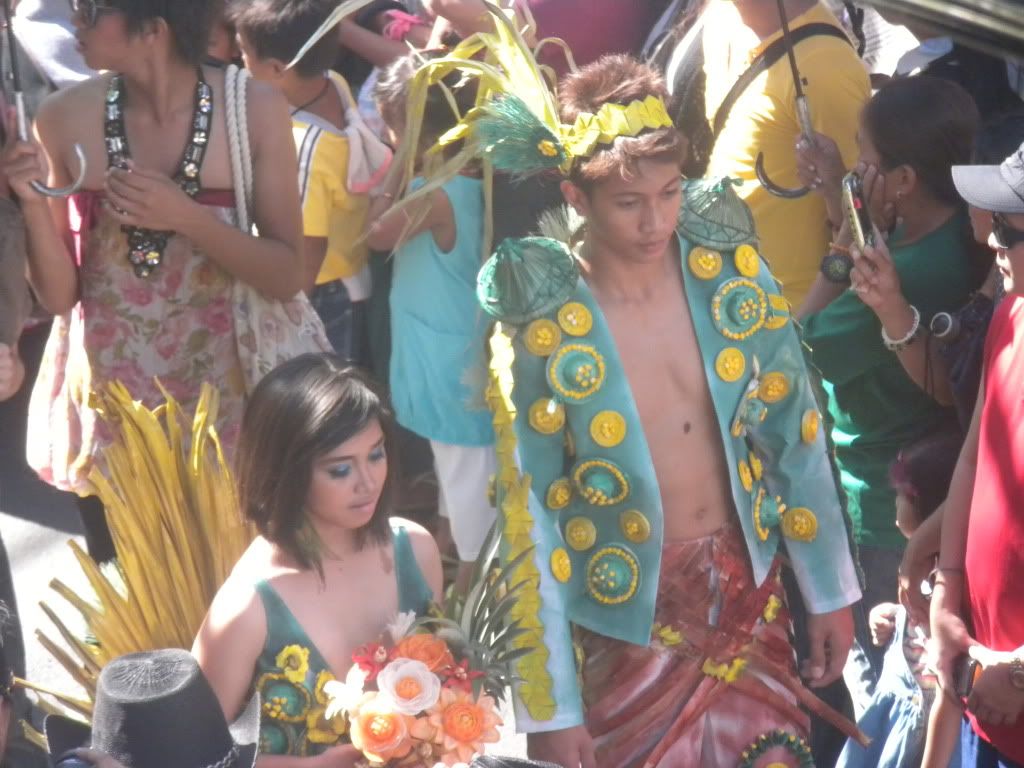
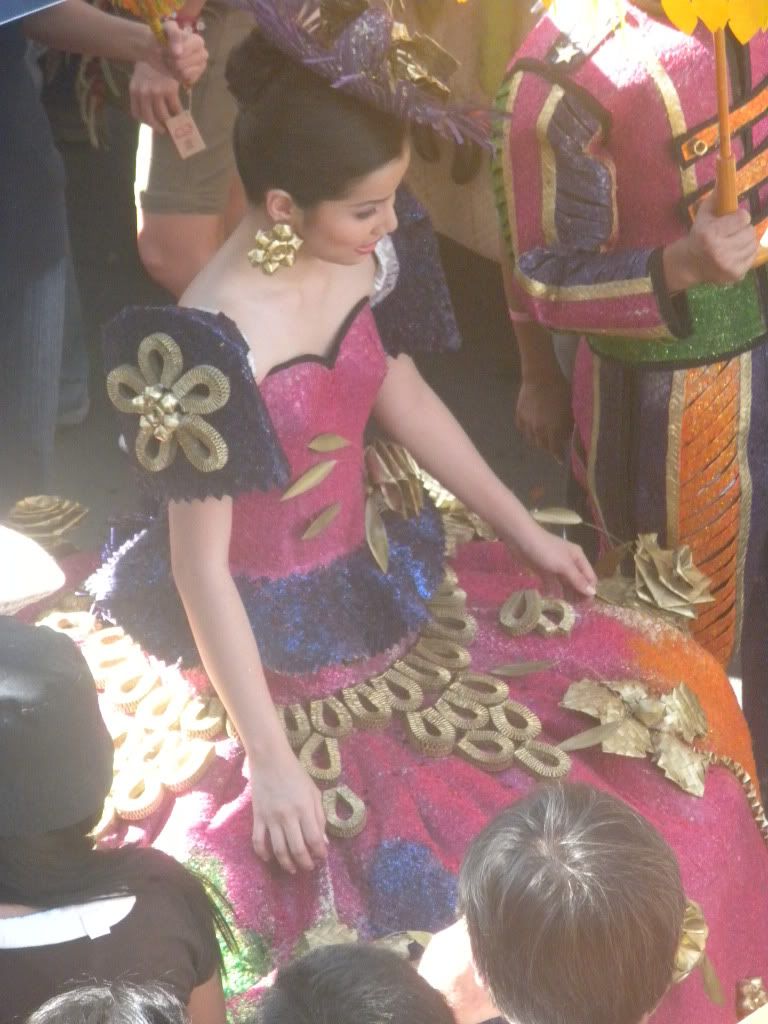
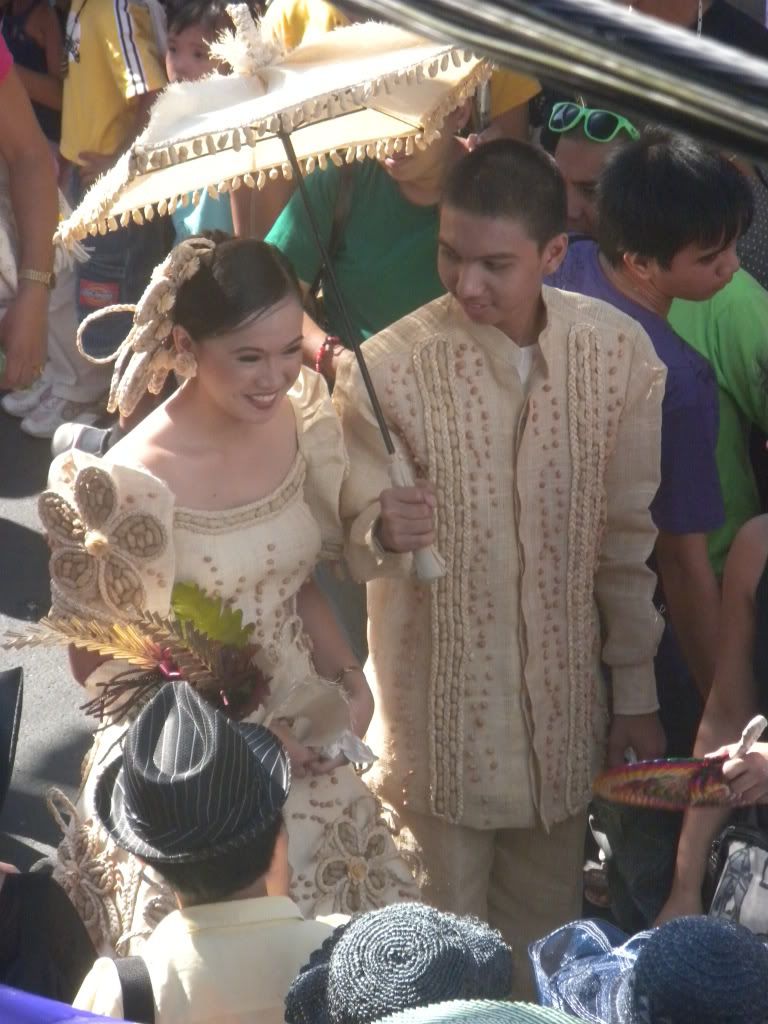
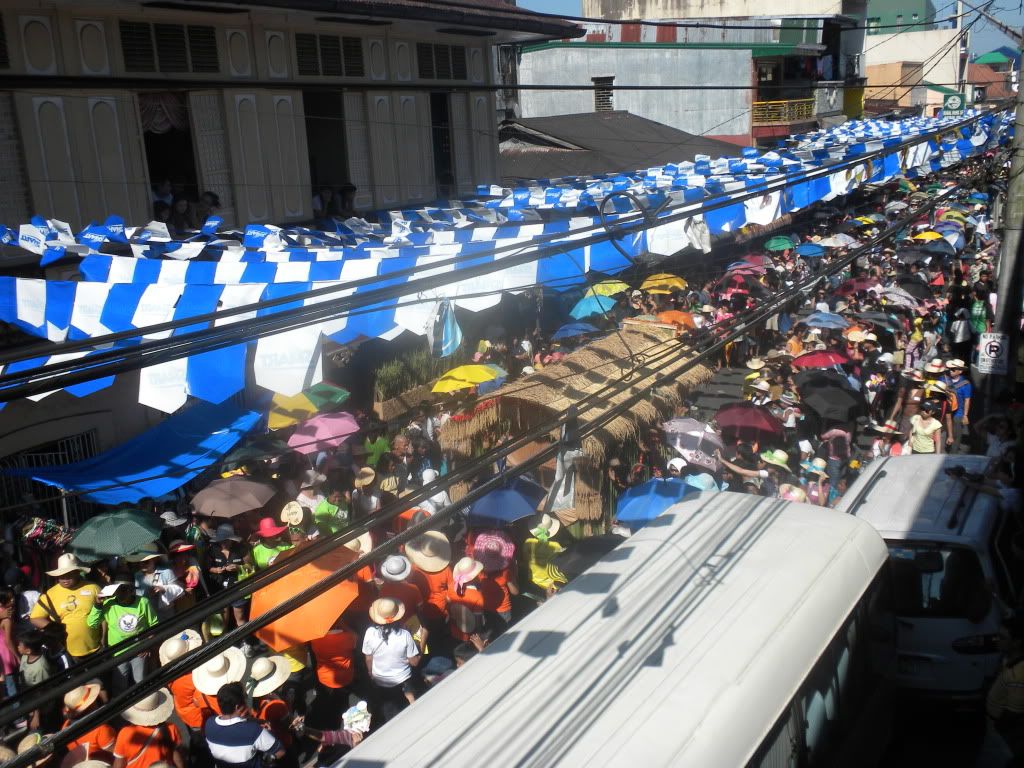

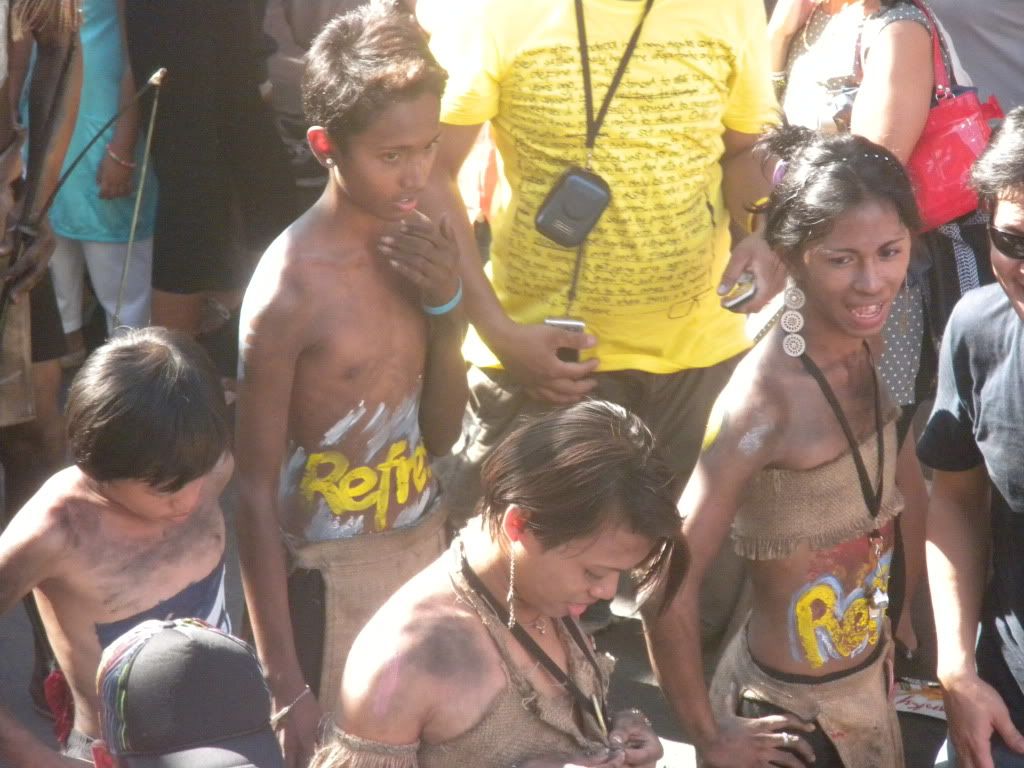
At one point Henk and I passed a ‘make-shift pinyata’ or so I’ll call it, because it was a bamboo basket with tons of bagged and canned food hanging off of it. Snacks! Henk used his long arms to reach above everyone and grab some of the good stuff! We later passed off the packaged noodles to some locals. I also tried the fried bananas on a stick, and a little cup full of fried kiping! You can actually eat the decorations on the houses! All you have to do is toss the kiping rice-wafer into a deep-frier and sprinkle a bit of sugar over it. Didn’t taste like much, pretty much only tasted like sugar, but cool to look at.
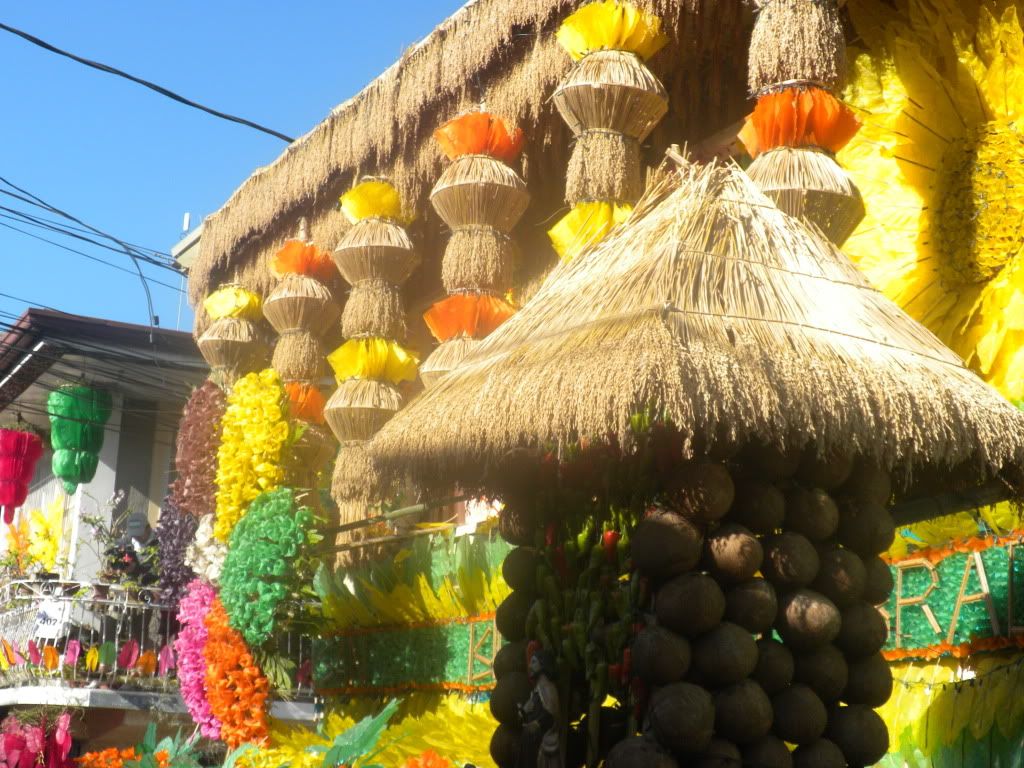
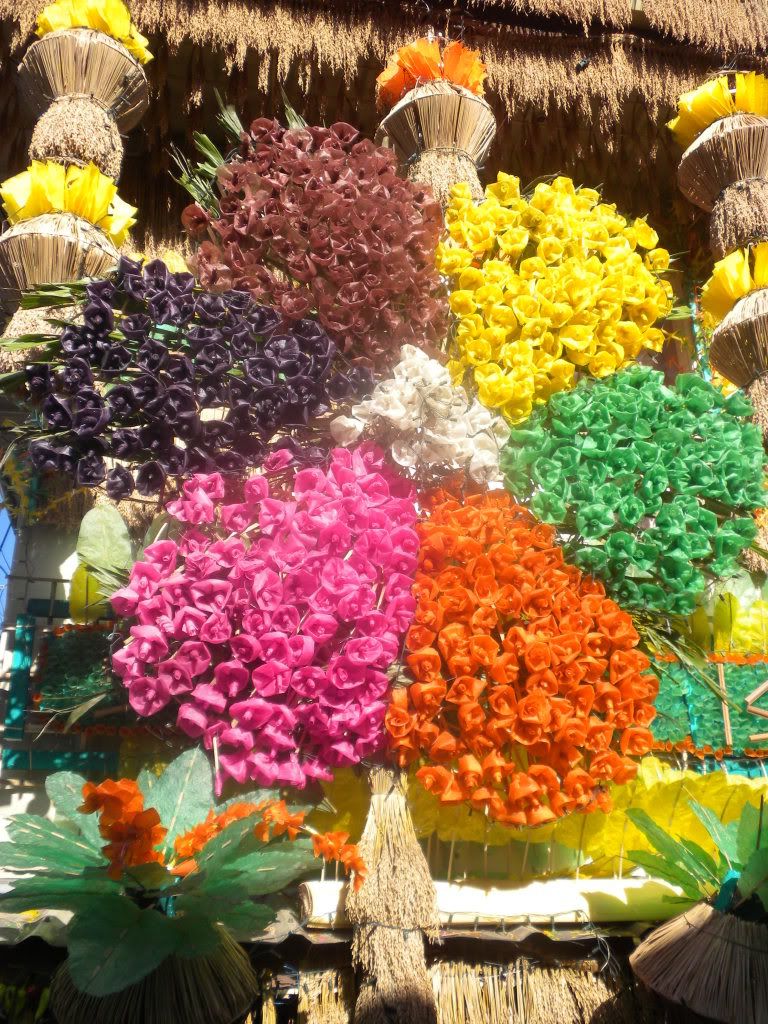
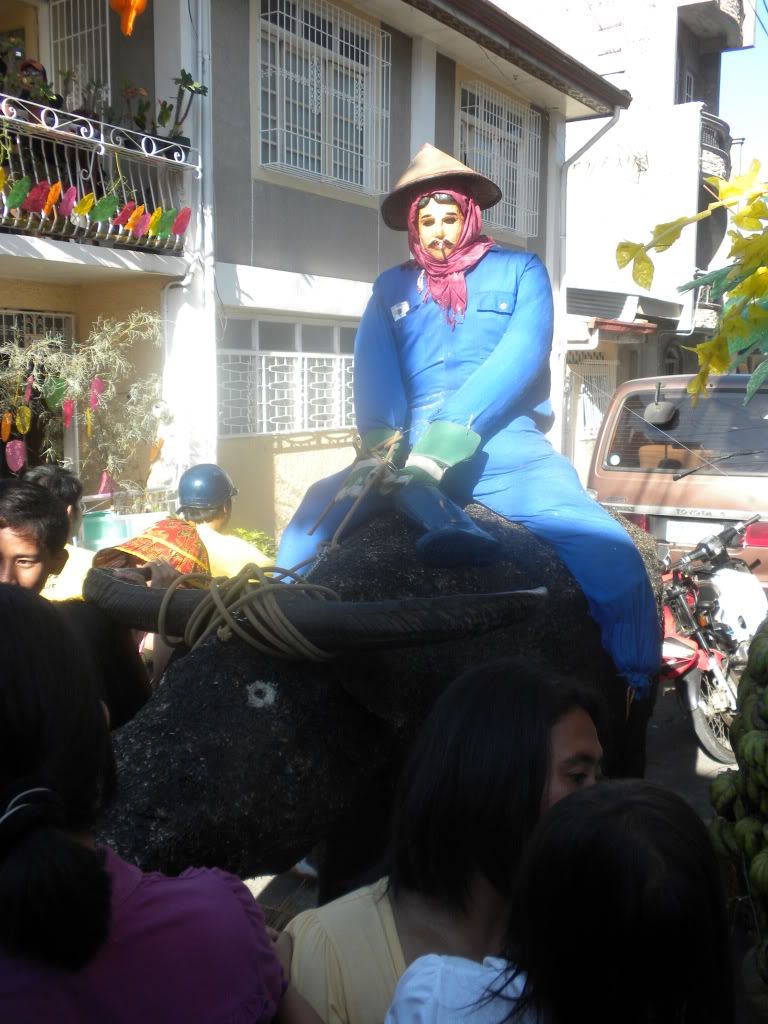
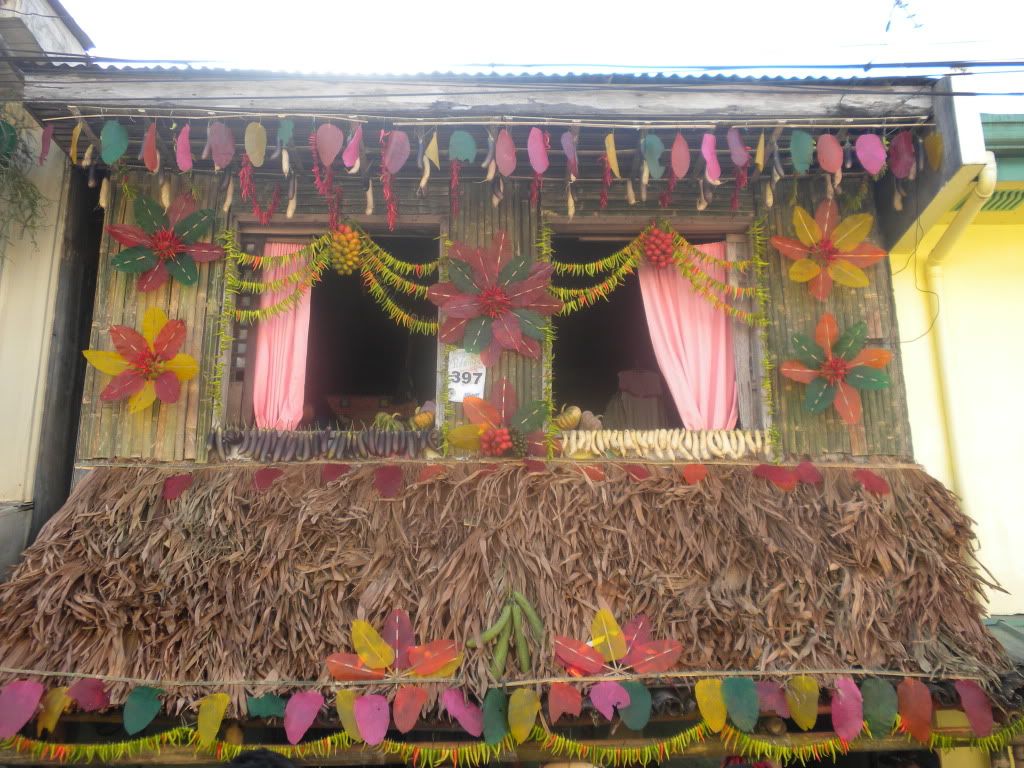
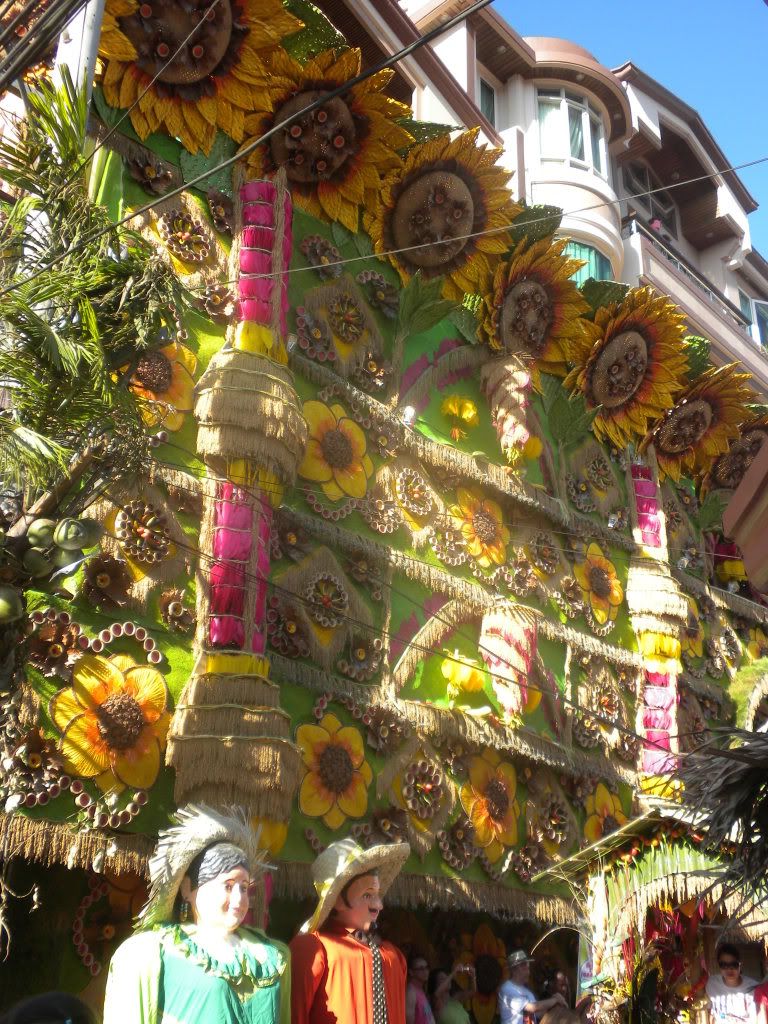
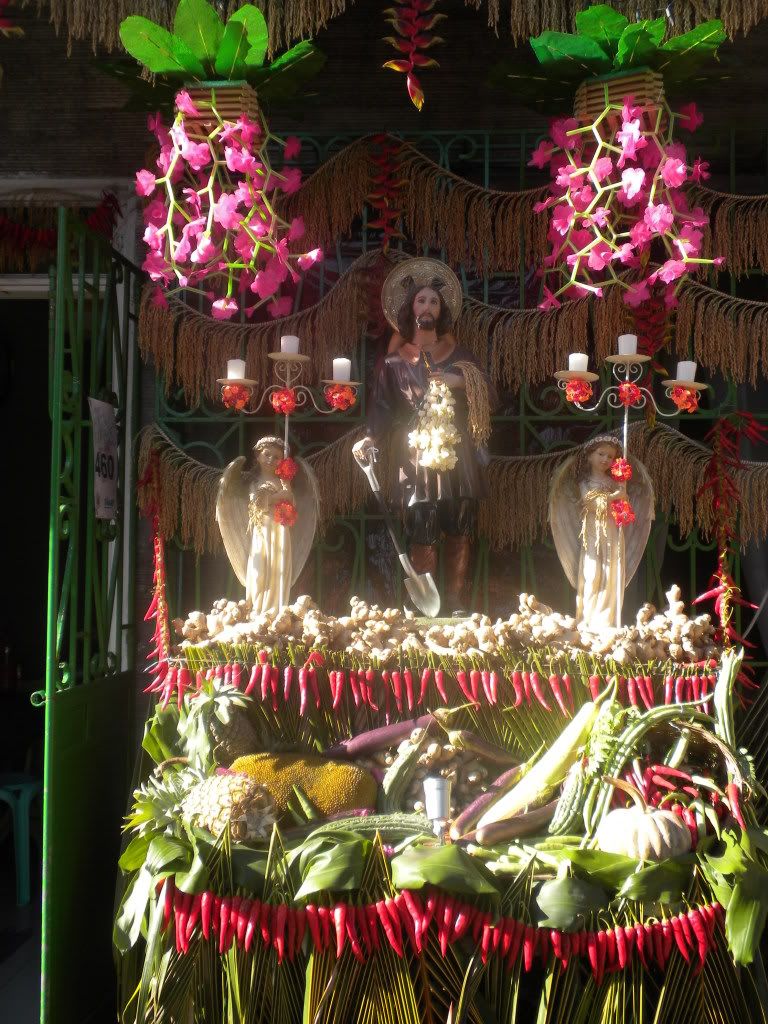
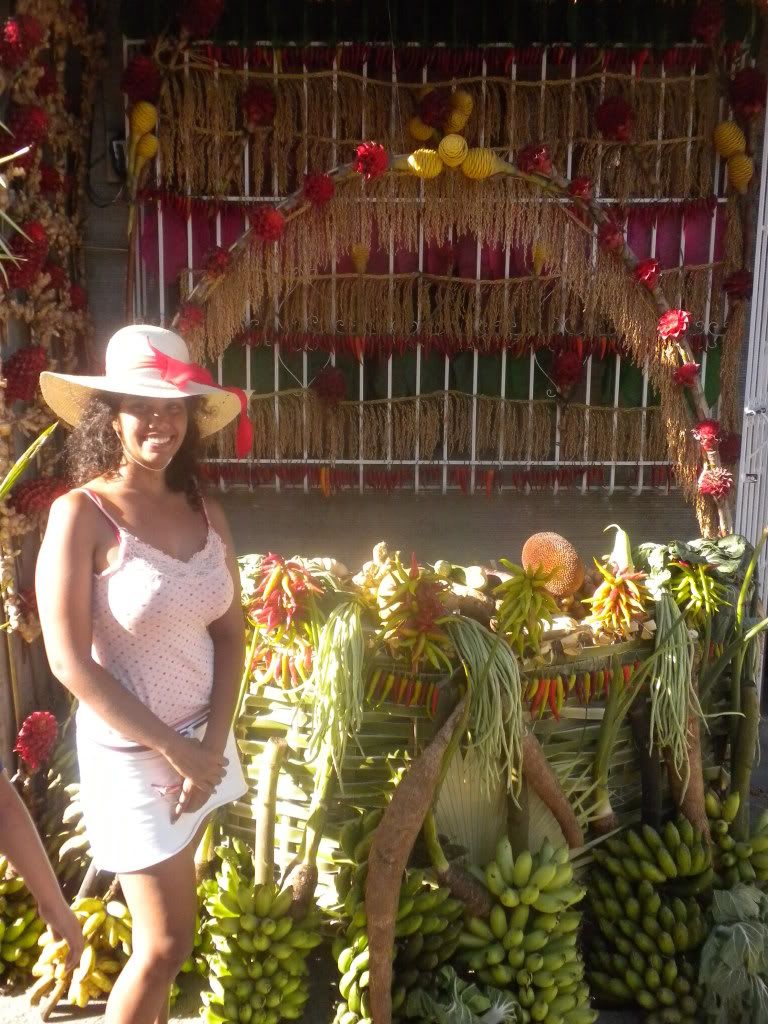
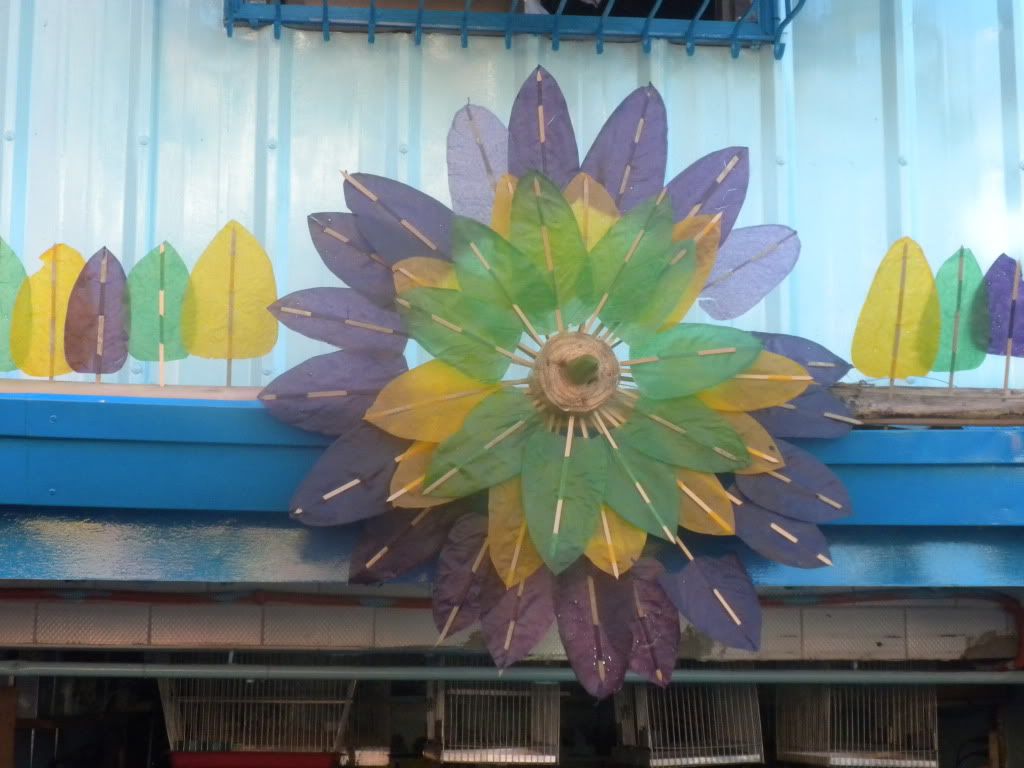
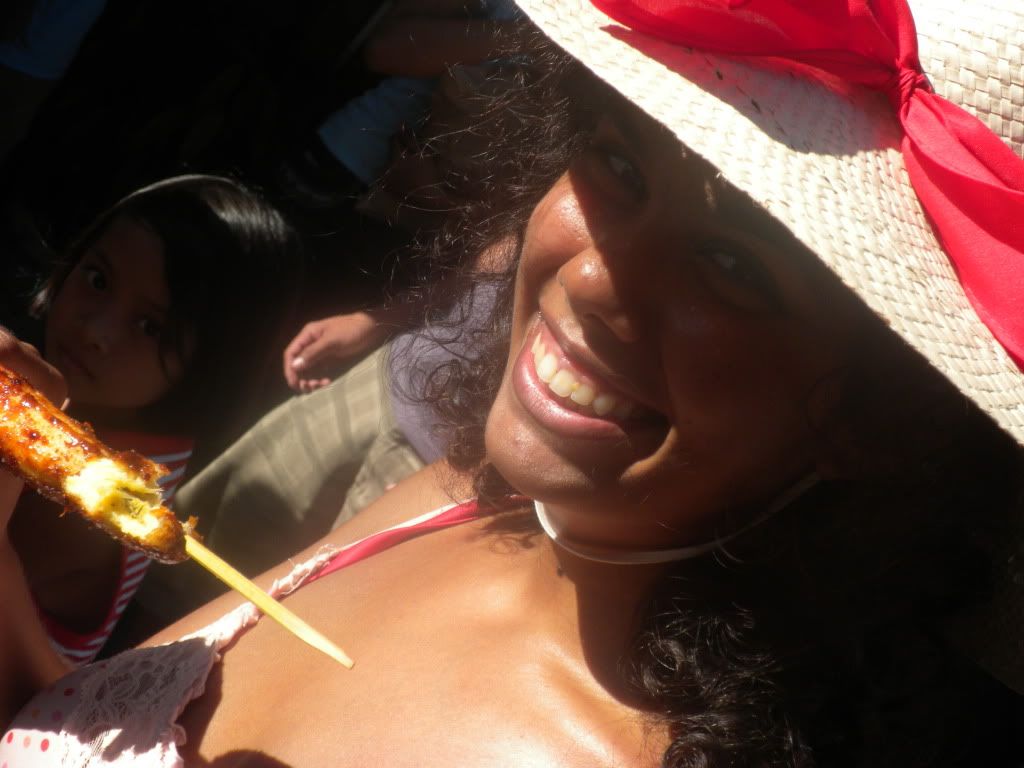
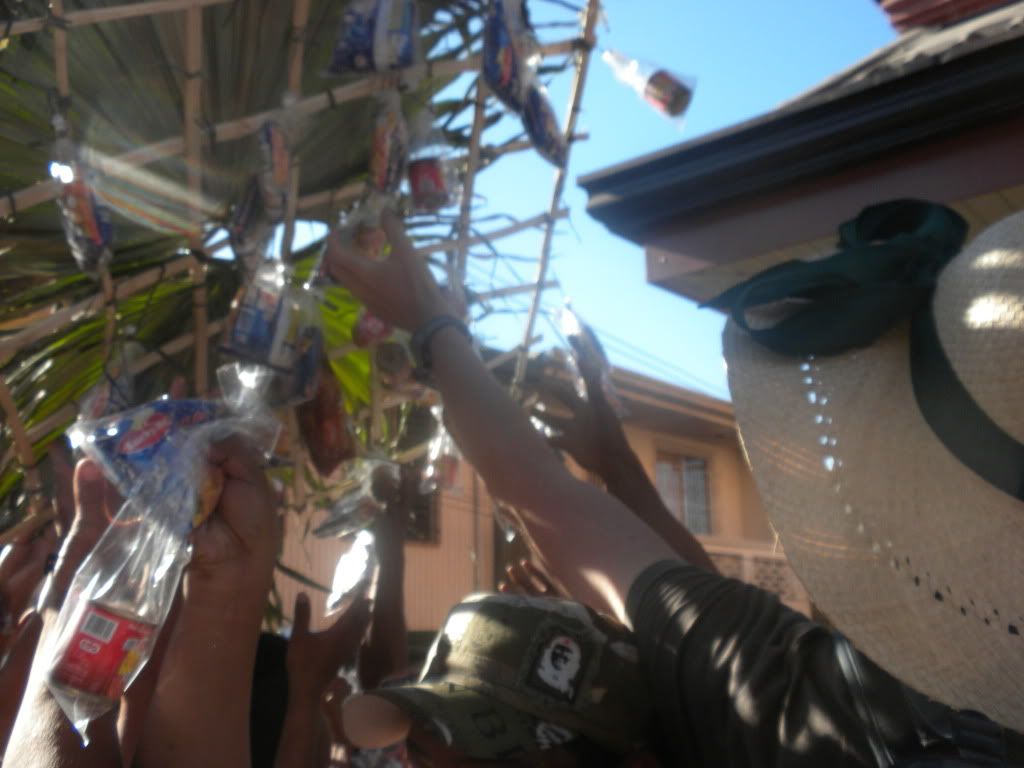
While debating if we should ditch our tour group, we ducked into the Parish of St. Louis Bishop to try and escape the blazing sun. We admired the large dolls representing various Christian saints and figures, then following the music outside to witness a bunch of kids doing a colorful dance. Upbeat music and cheerleading moves made it hard for us to believe this dance was anything historical, but it was interesting to watch regardless. It was however another church that caught our eye as we made our final walk through the festival streets. The Lucban Catholic Church that won the decoration contest. According to our paper guide, this church is a “…blending of Baroque and Castilian architecture, measuring 180 feet long and 38 feet wide.” It is apparently dedicated to the Virgin Mary.
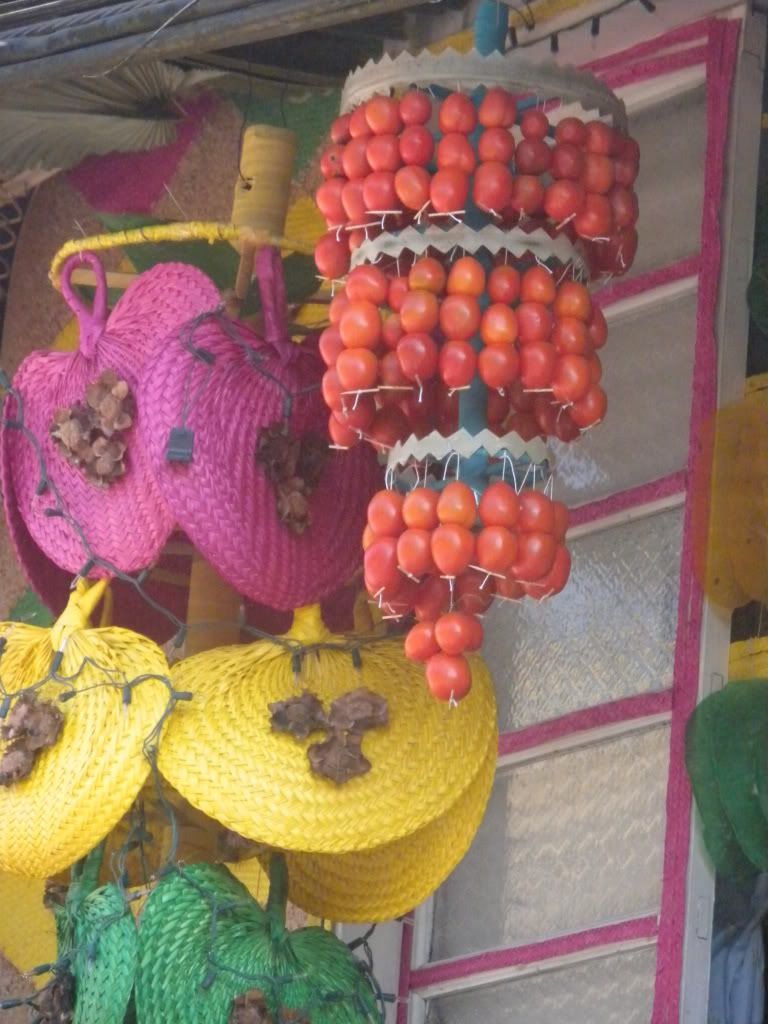
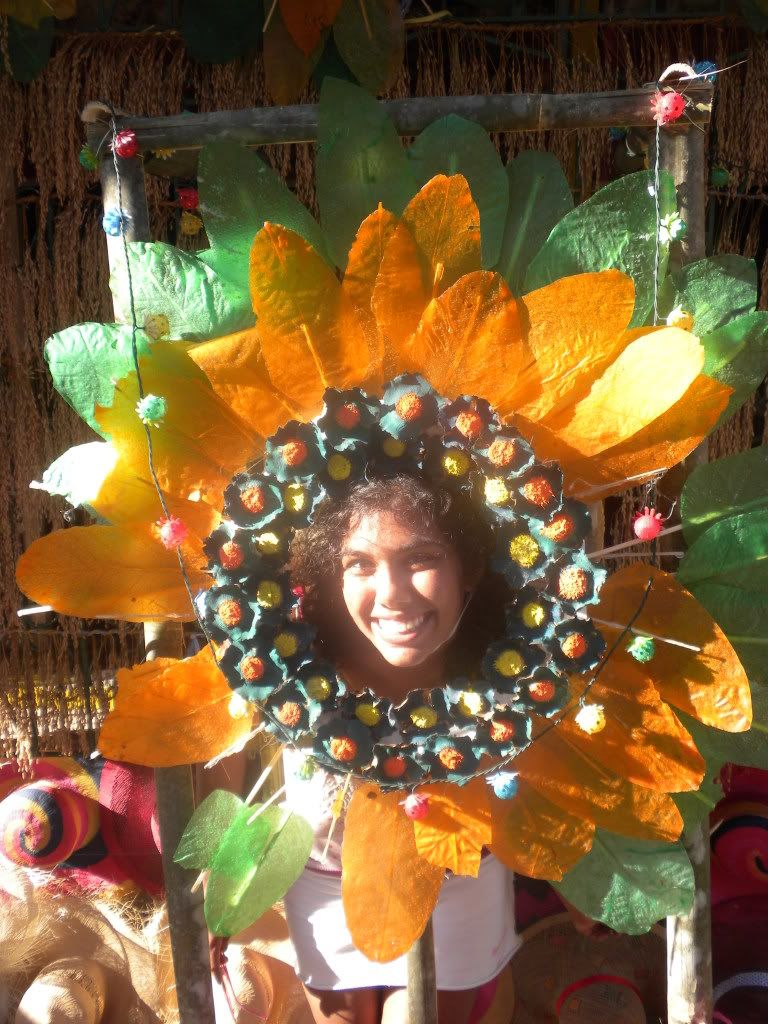
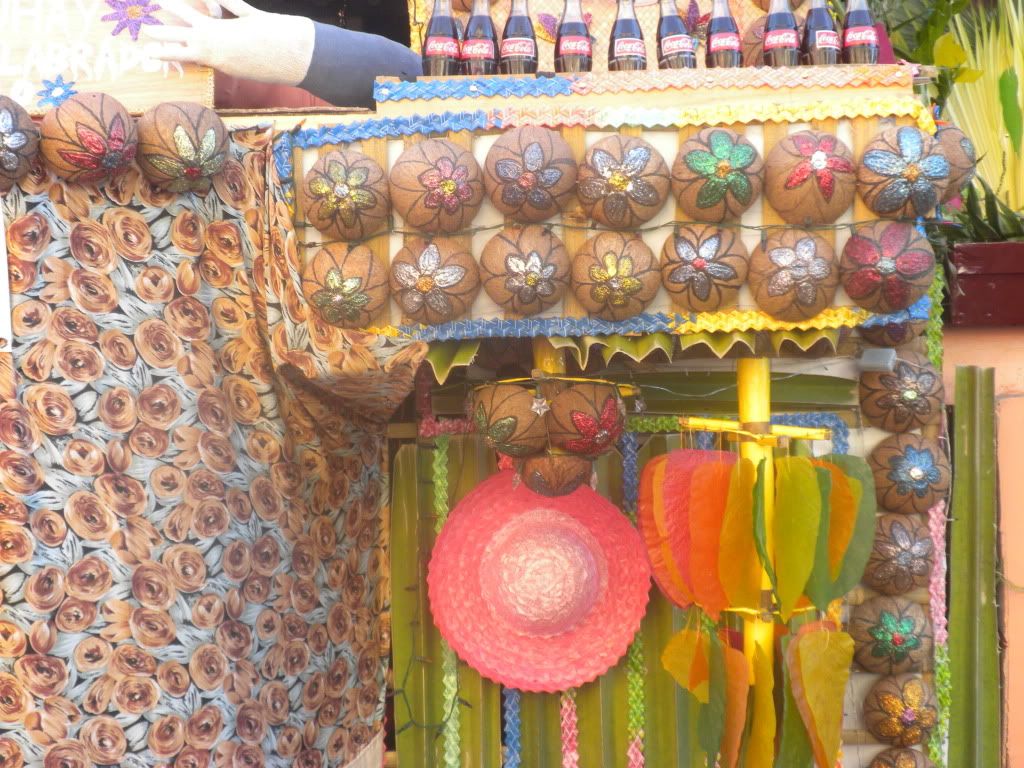
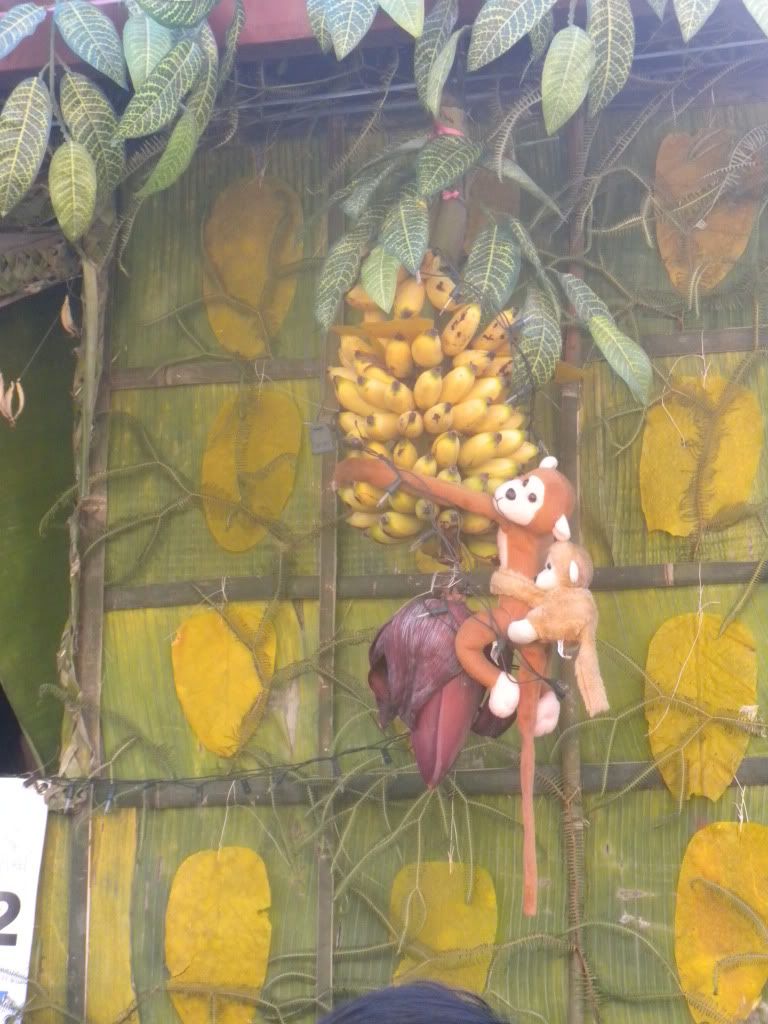
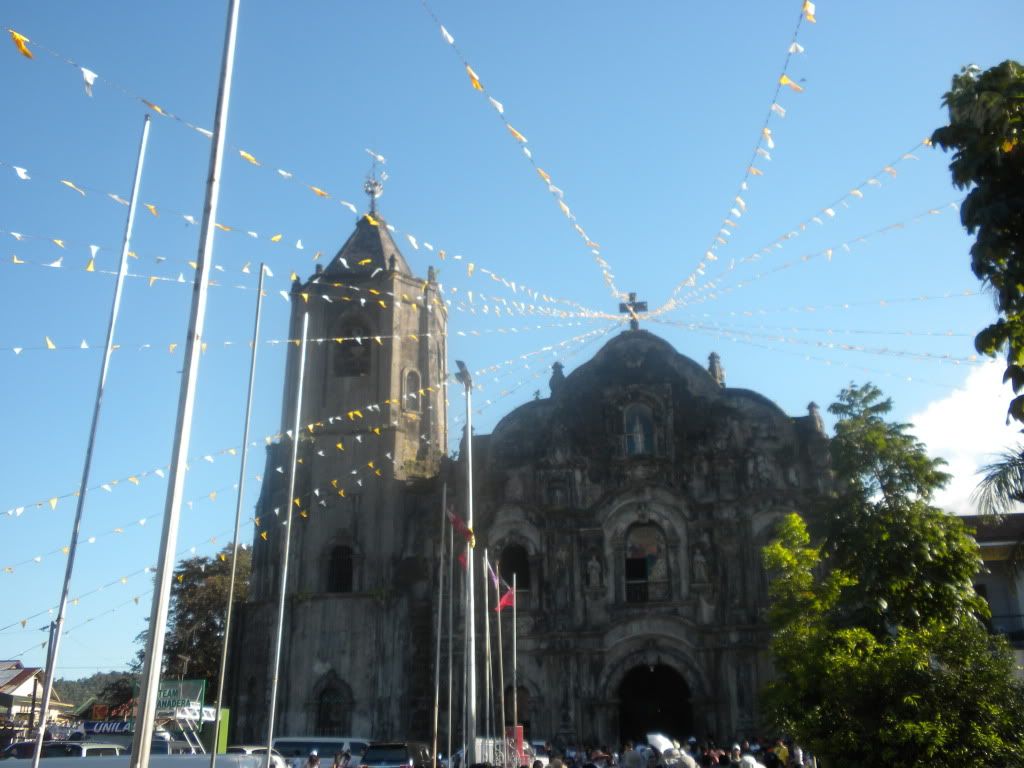
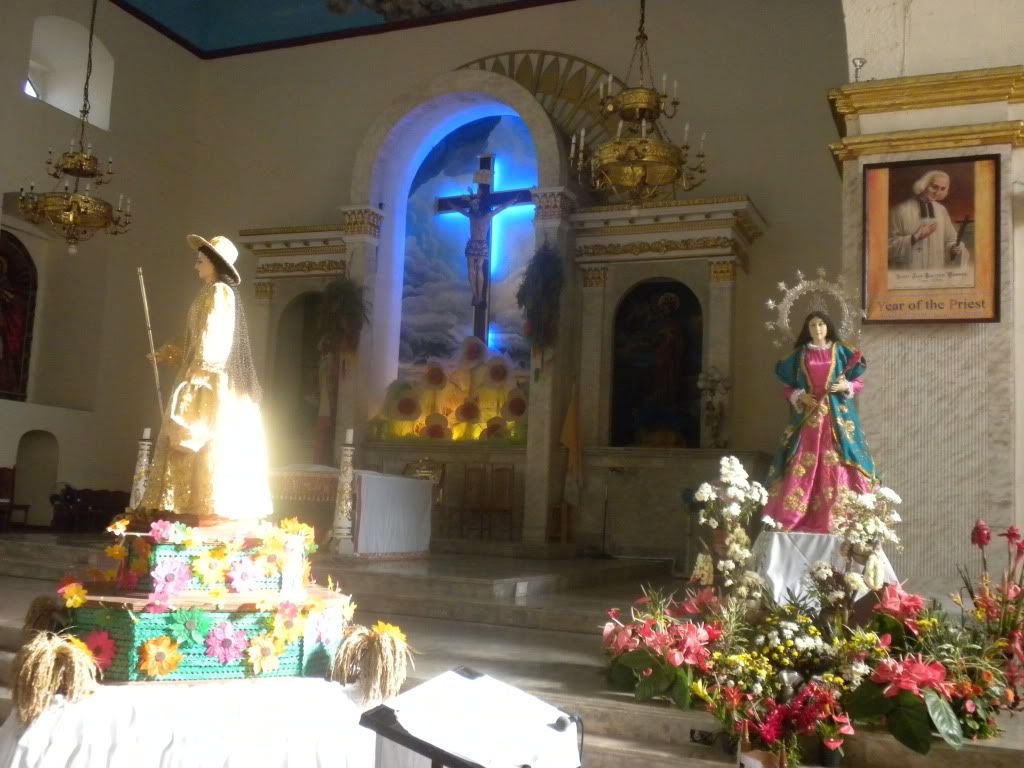
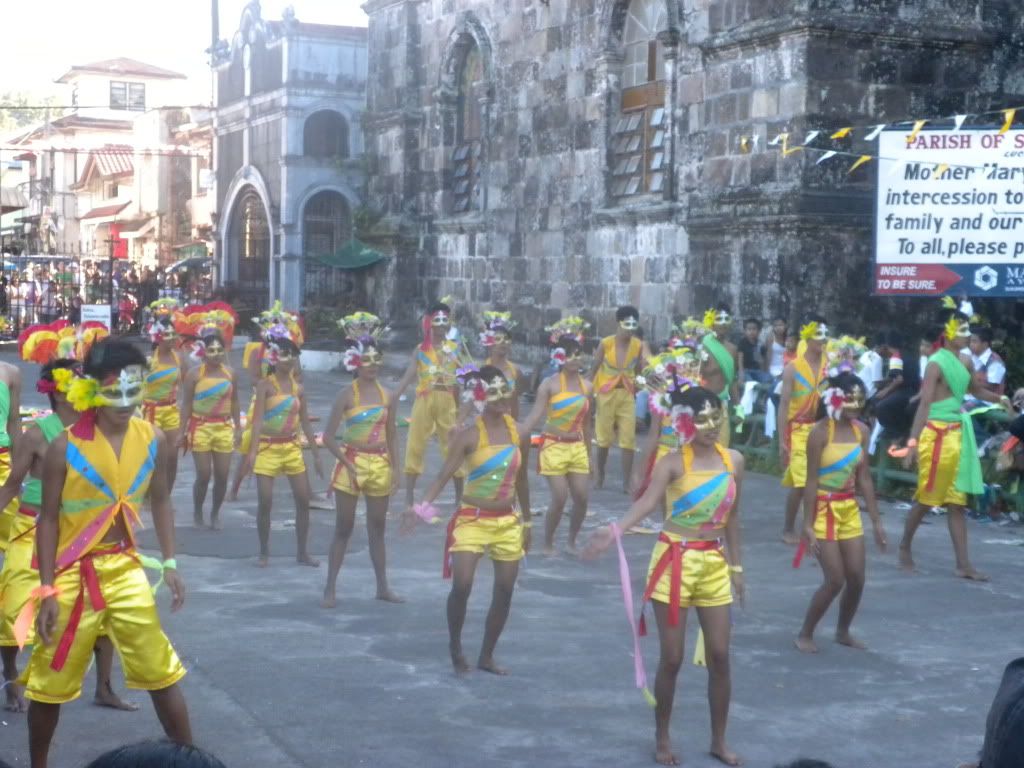
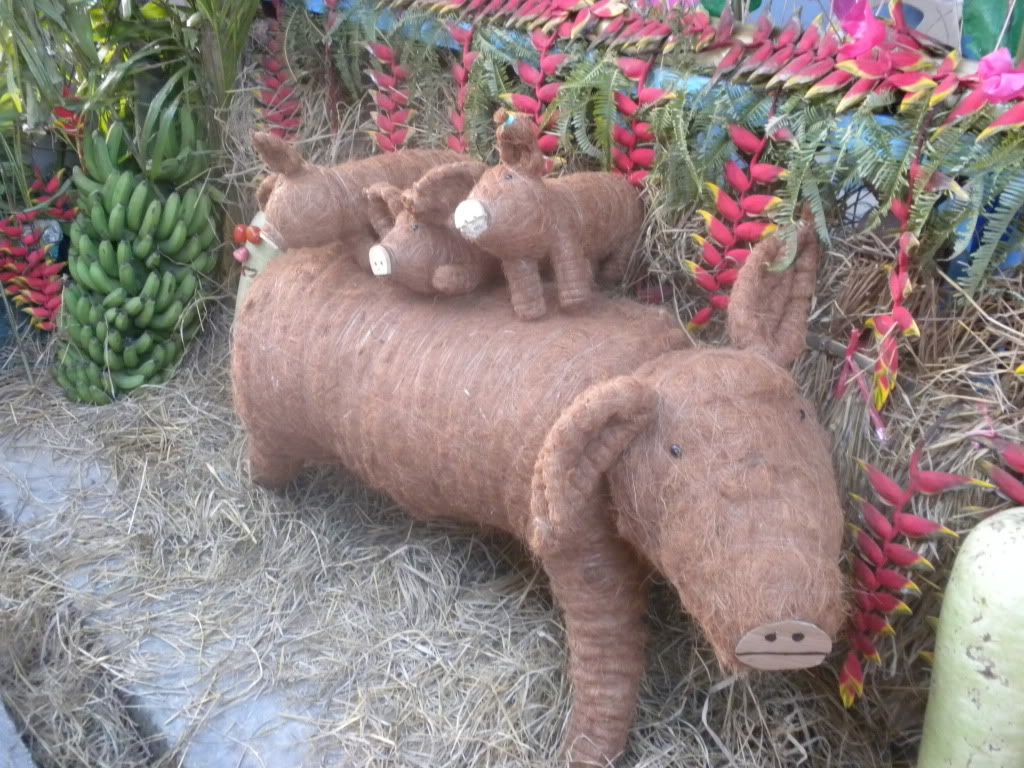
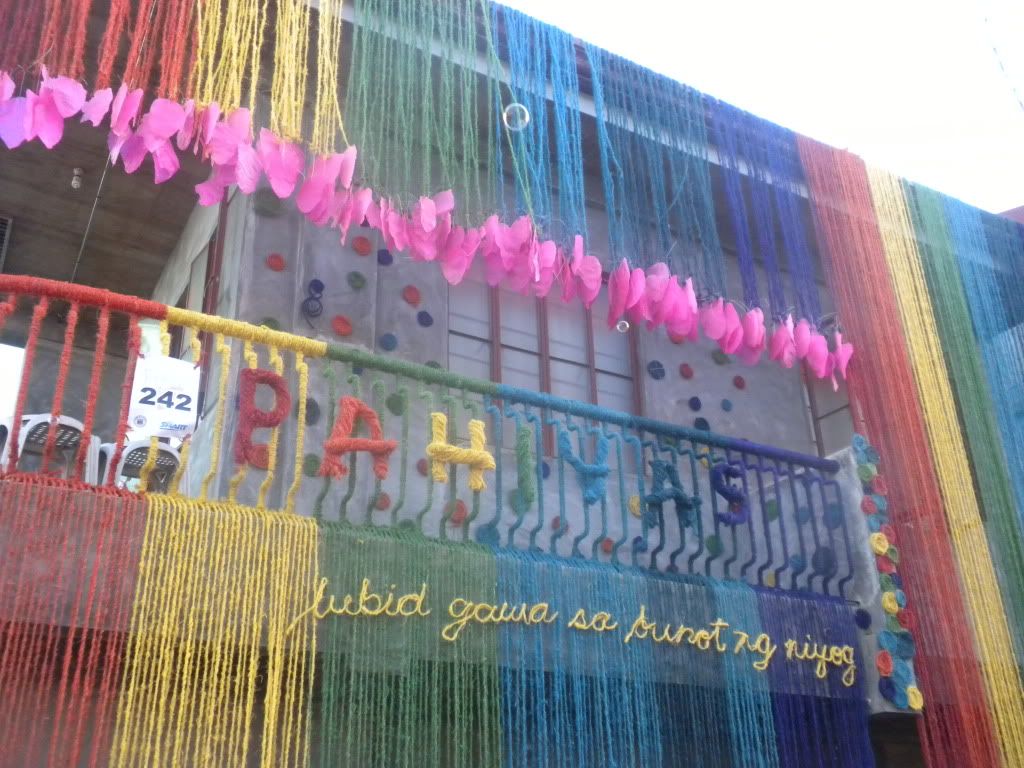
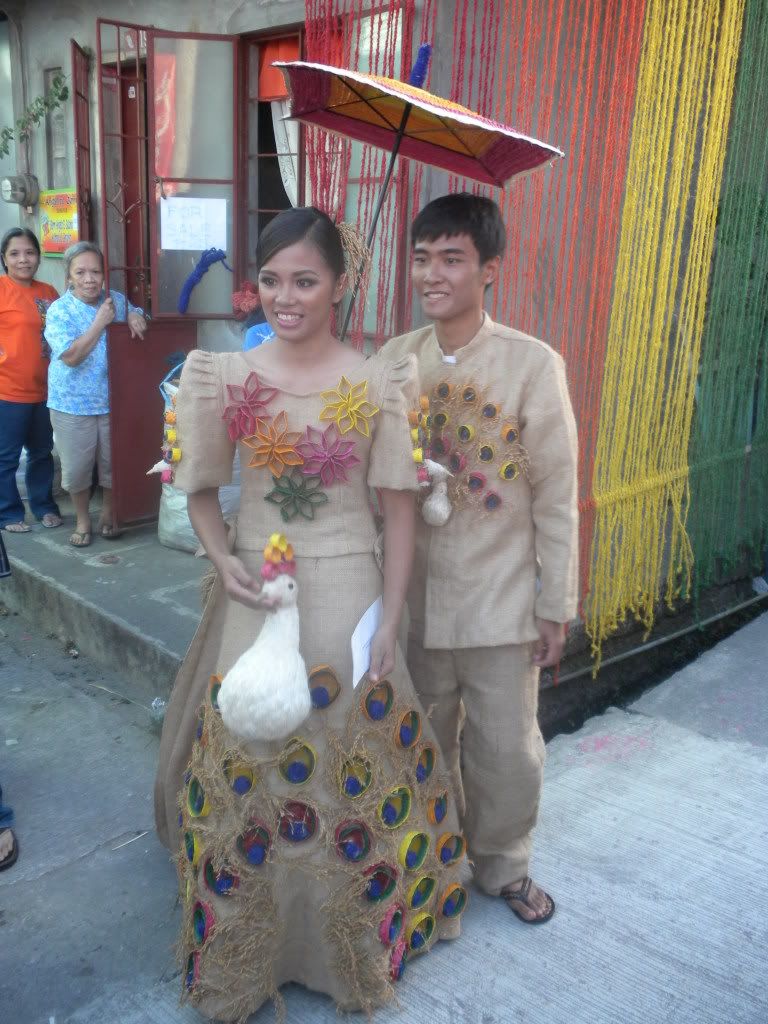

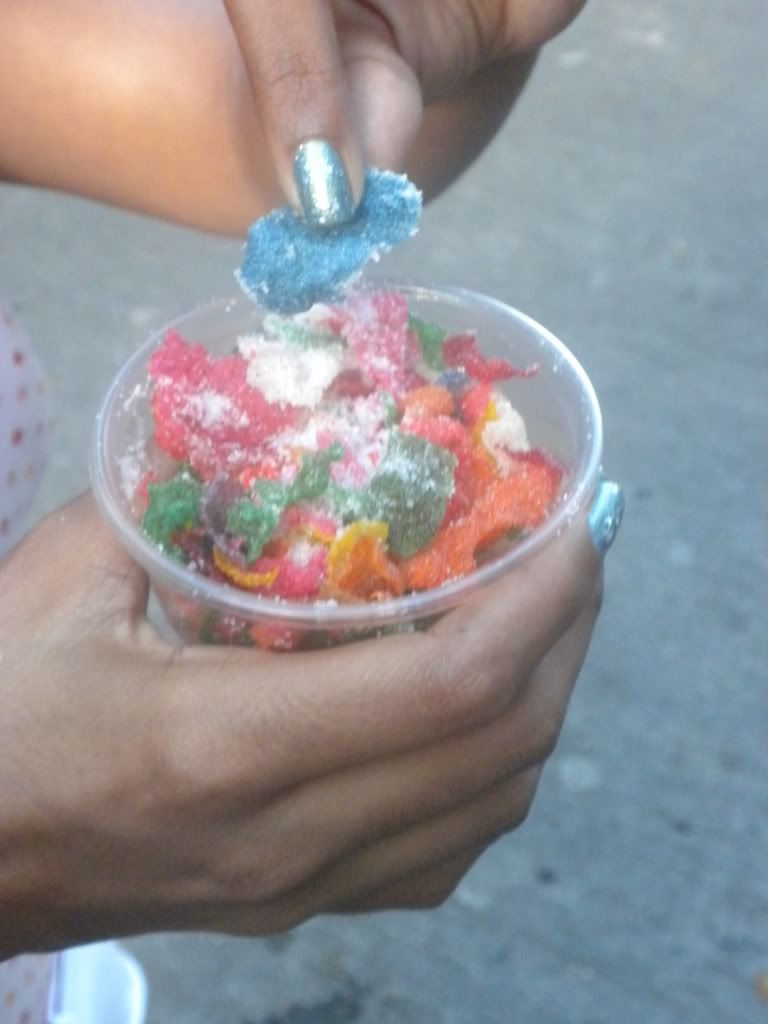
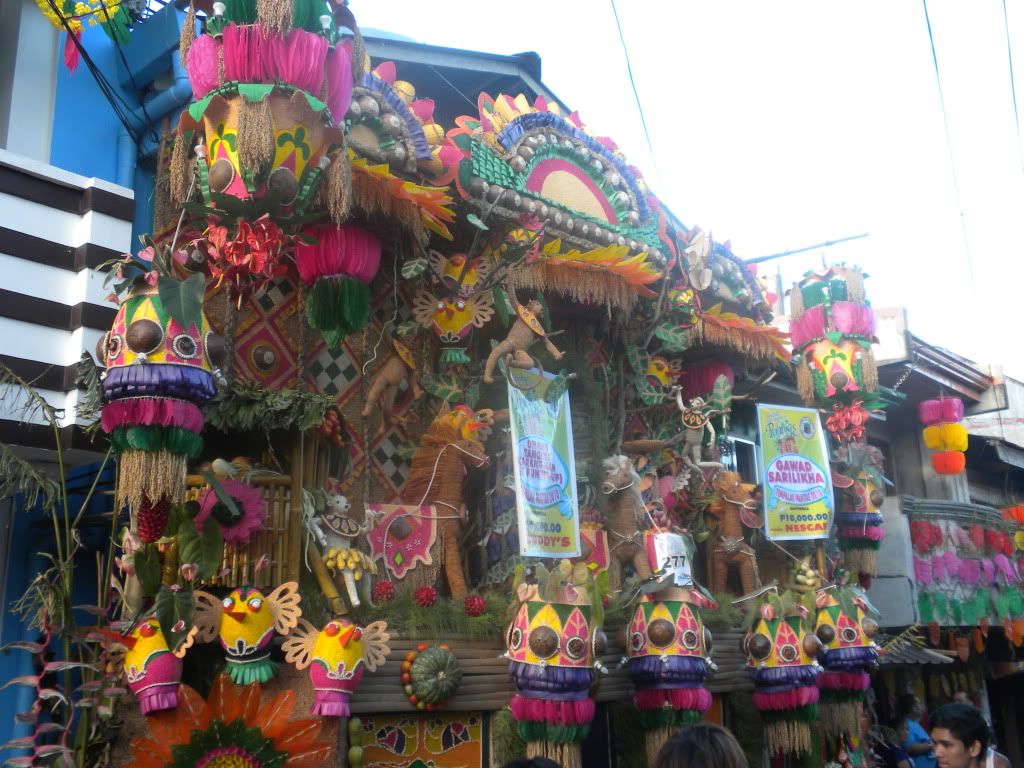
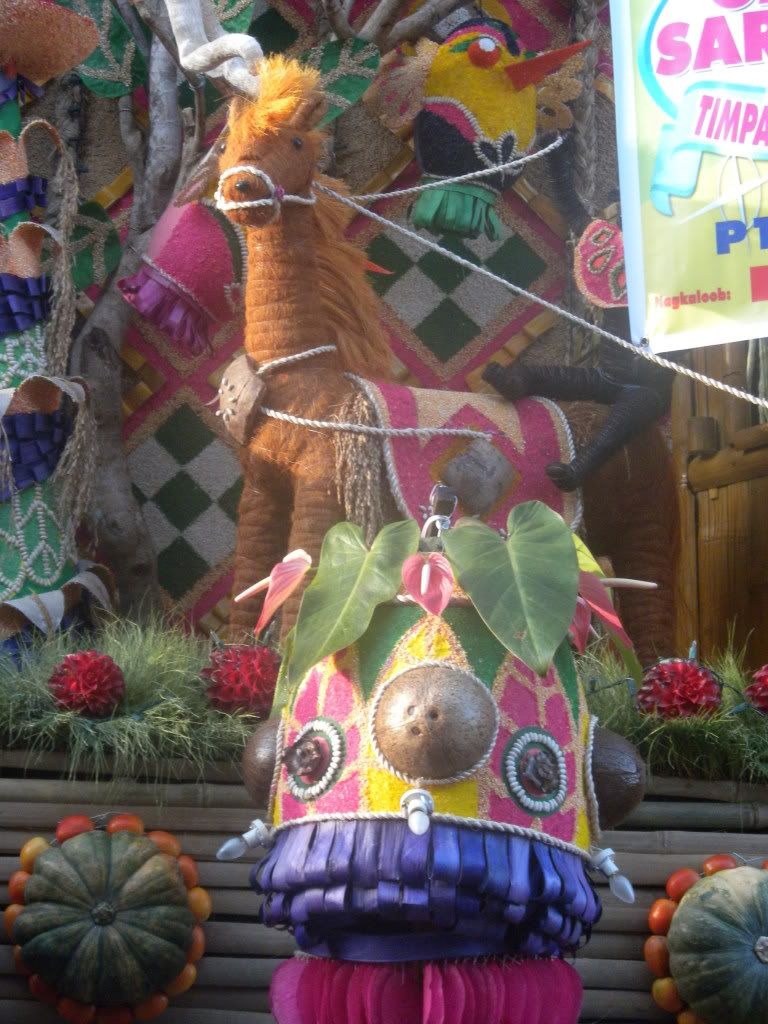
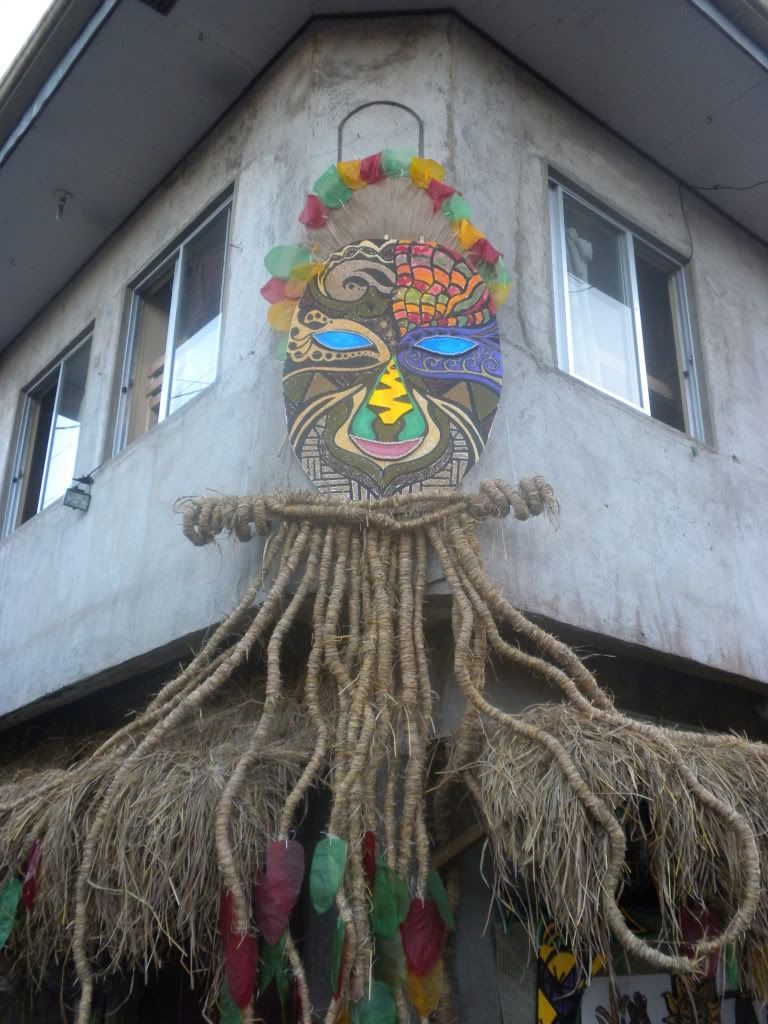
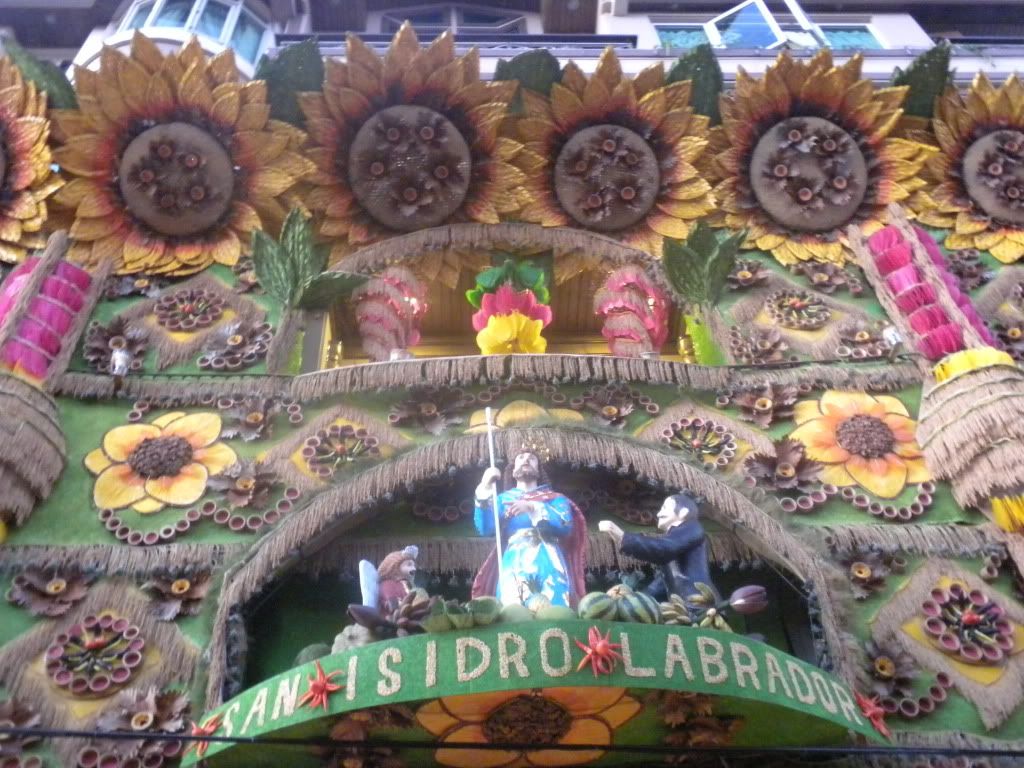
That evening we caught a tricycle to a jeepney where we were driven to a bus which would take us to Quezon City. Then, we had to get in a taxi to get back to Manila where our hostel was. Well past midnight we finally arrived at Friendly's. What a horrible trip back that was! We crashed when we got in — we wanted to rest up for the next afternoon. We had a tour to attend!
Henk and I wanted to sleep in on the 16th, but we were going to try and do some more couch surfing to meet a few local people! However, the realization the day before about the traffic and travel time around Manila turned us off to the idea of having to venture outside of Manila to stay with someone and catching a taxi back into the city every day to tour around. We were supposed to house with a friendly girl and her mother, but feared traveling back and forth would seriously cut our exploration time. We ended up just switching to a larger room in the same hostel and booking in for a couple more nights.
I have to tell you all about the fantastic place we went to for lunch that afternoon! It was called Café Adriatico and we found it recommended in our map of Manila and the Lonely Planet. WOW, were they right to point us in that direction! We couldn’t decide what sounded better, so we ordered a little feast: warm minestrone soup, delicious bruschetta, some pesto-sauced spaghetti, and an out-of-this-world triple mushroom and cheese mini sandwich on soft ciabatta bread. Amazing!! One of the best meals I’ve ever had was that little mushroom delicacy. It even came with a balsamic vinegar side salad of cucumbers and tomatoes that blew me away – and I am not a fan of vegetables. To top it all off, the prices weren’t bad either. We plan on having a slice of their baked-in-house chocolate cake when we get back to Manila.
Just before 4:00 PM we arrived at Fort Santiago in the walled city of Intramuros. We were there for the infamous tour by Carlos Celderan called, ‘If These Walls Could Talk: the Deluxe Version.’ He started by singing the National Anthem, following with a brief history of the Philippines islands. He explained to us that the islands were on the volcanic ‘ring of fire’ but that this was not the sole source of the national volatility. Previous to the Spanish, the Filipinos built their houses and structures of bamboo; they had no natural known source of stone. Where the Fort Santiago now stands, there was originally a Fort of Rajah Soliman, the native Tagalog chieftain, and the area was a center for trade. When the Spanish came, they began using volcanic ash to create adobe thus rebuilding the Fort and changing the architecture of the Philippines forever.
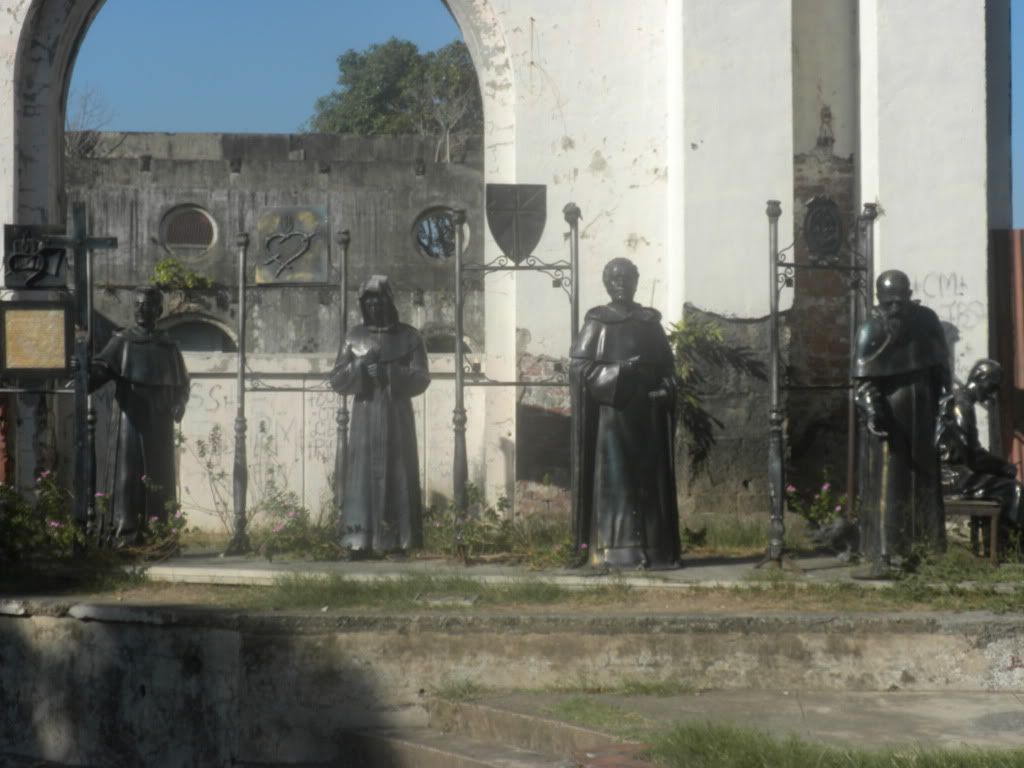
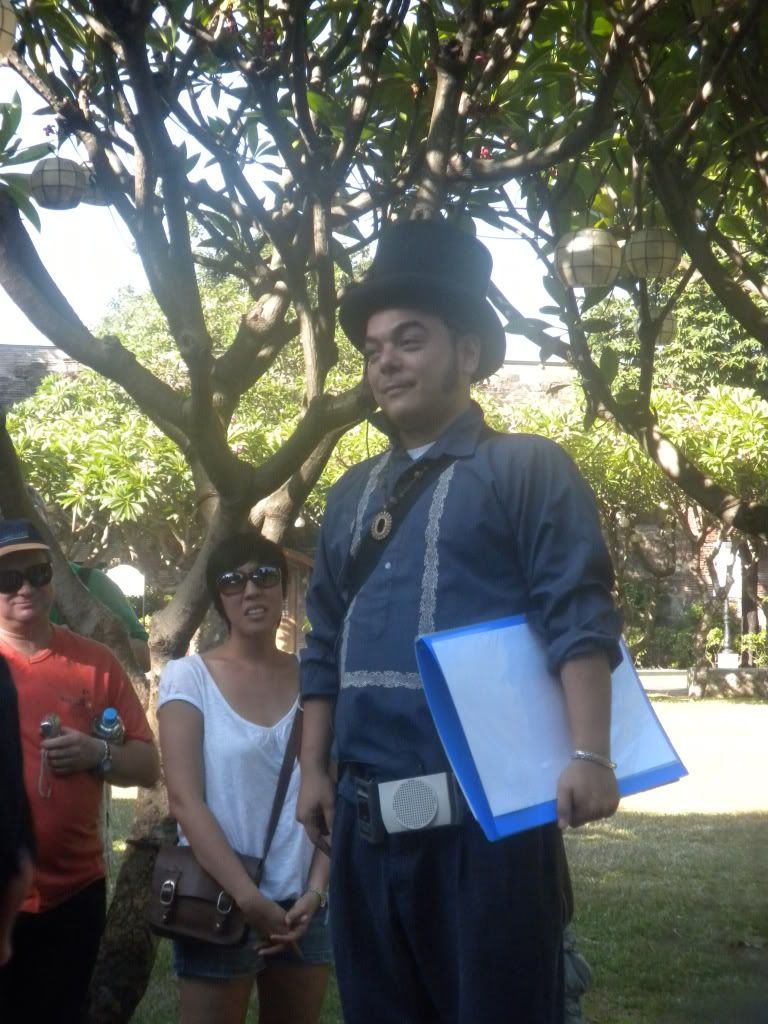
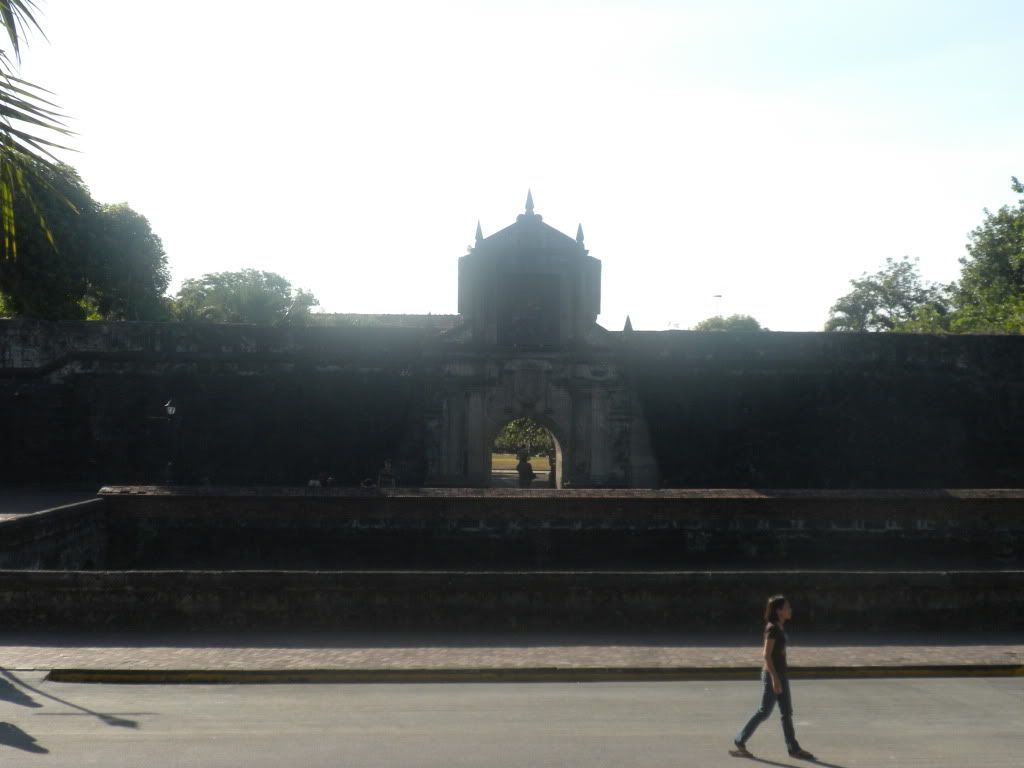
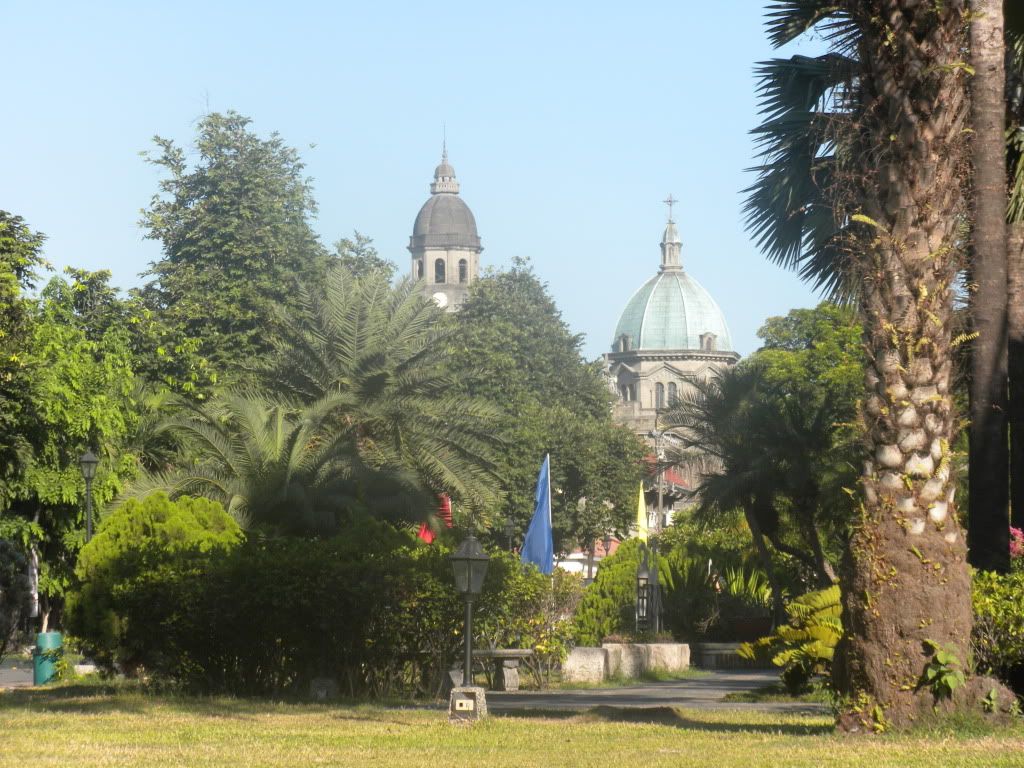
Carlos explained that the national language of the Philippines, Tagalog, which combines Spanish, English, Malayu and older Eastern words to form a mix, understood by the people today. As we were walking in the Fort, he added as a sidenote for us to notice the relief carving above us on the gate arch of a Saint James killing Muslims (Moors) on the Fort. Carlos was adamant about viewing Manila in a ‘different light’ than usually seen; Manila is thought of as an unattractive city when in reality it has a dramatic tale and a striking history.
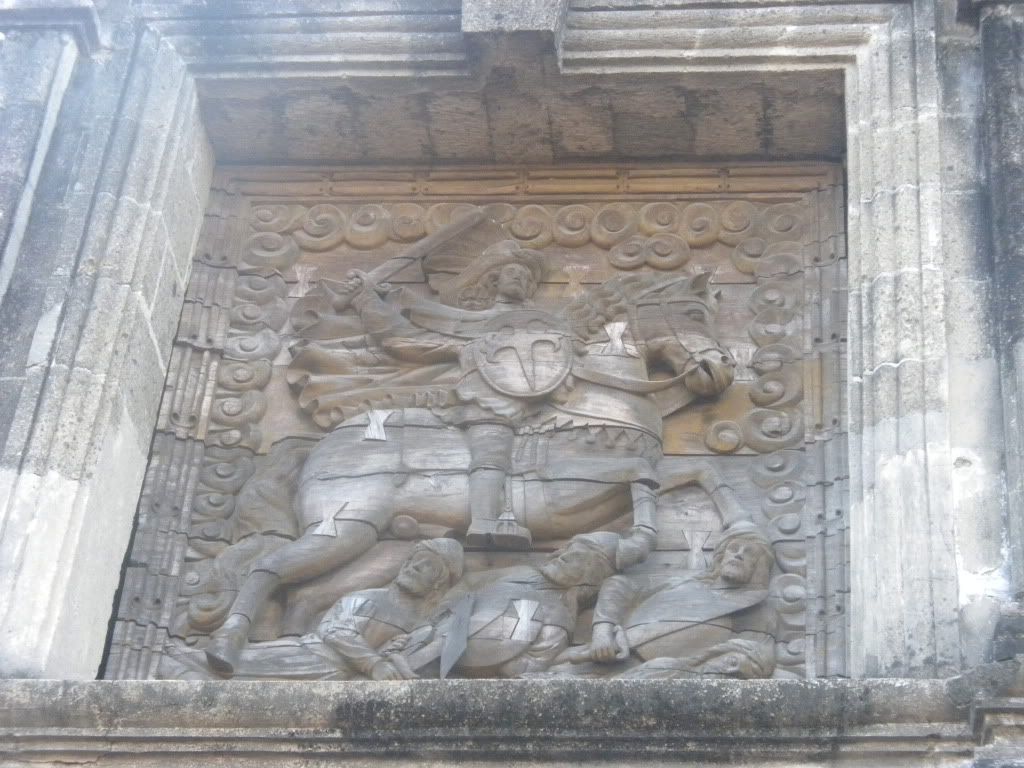
Starting from the colonialism brought by the Spanish (including theocratic rule in the city by the friars), followed by the colonialism by the Americans (and eventual destruction of Manila), and ending with the re-creation of the Filipino people he told Manila’s story. The Spanish, led by Martin de Goiti and later Miguel Lopez de Legazpi conquered the native city and founded the city of Manila where it stood. Walls and a moat were constructed around the city, closing it off to invasion by the Chinese and Japanese pirates – even the Dutch tried to attack the city, and the British successfully held it for 2 years.
Carlos pointed to a statue of Rizal on the lawn of the Fort, the country’s national hero. Rizal wrote 2 books criticizing the theocratic rule his country was under during Spain’s time there. He was eventually shot in the head for ‘inciting revolution in the people.’ (More about him later, as we visit a great wax museum on his life!) We were then all loaded onto carriages pulled by horses for a ride over to the Church of San Agustin, Manila’s only standing Church post-WWII bombings. While you might think initially ‘How could a Church, a Spanish-Catholic concept brought to the Philippines, be a uniquely Filipino example of architecture?’

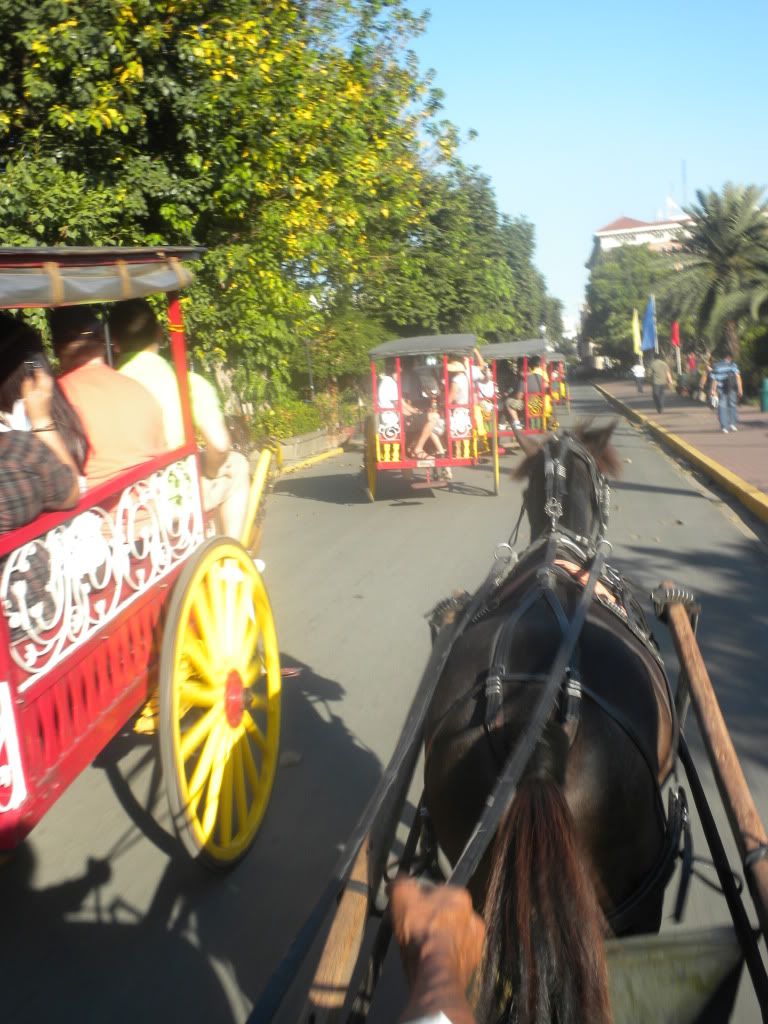
Carlos explained that Filipinos have always absorbed various ‘new’ cultures into their own. They love excess to the extreme. For example, the Church itself once you strip away the decoration is just a simple building: the carvings are all painted on (yes, look at the detail picture!) and the columns are not a structural part of the building – just for pure decoration. There are even Chinese lions out front; that was clearly not a Filipino invention! But using a Chinese lion on a Catholic Church? Pure Filipino.
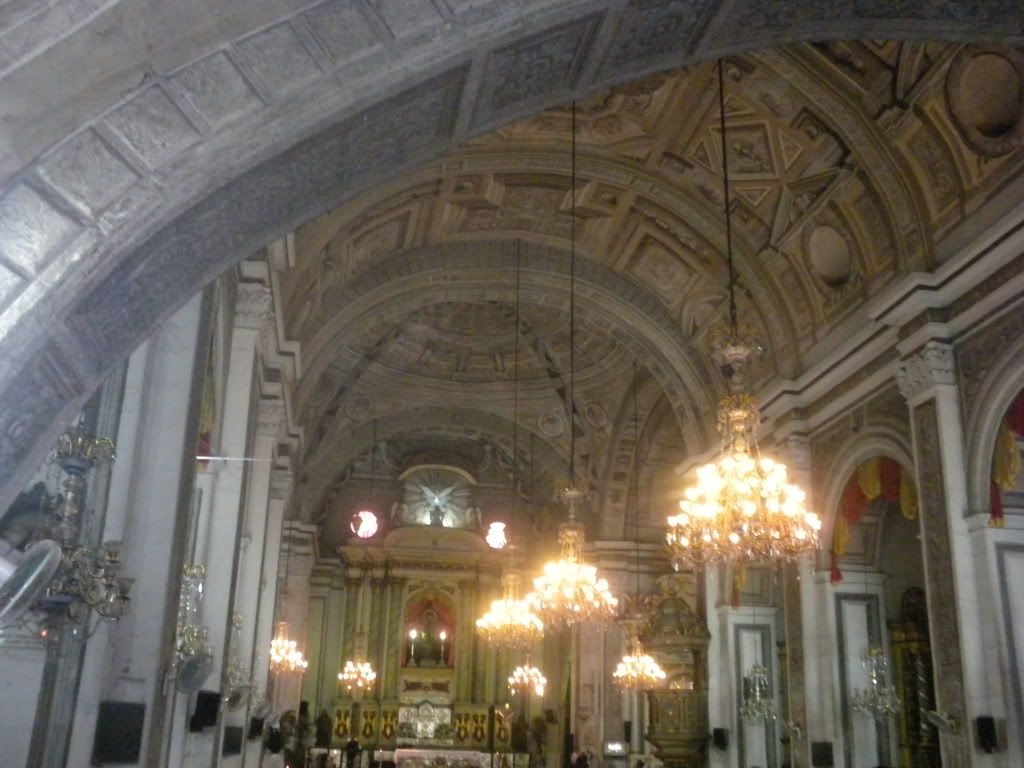
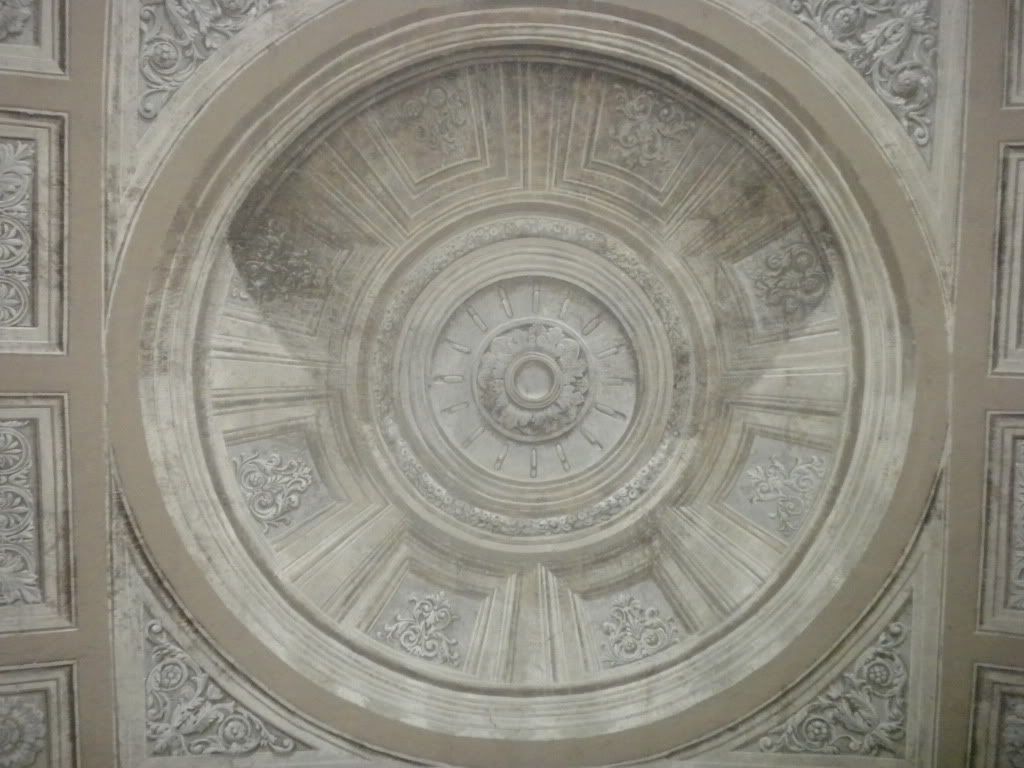
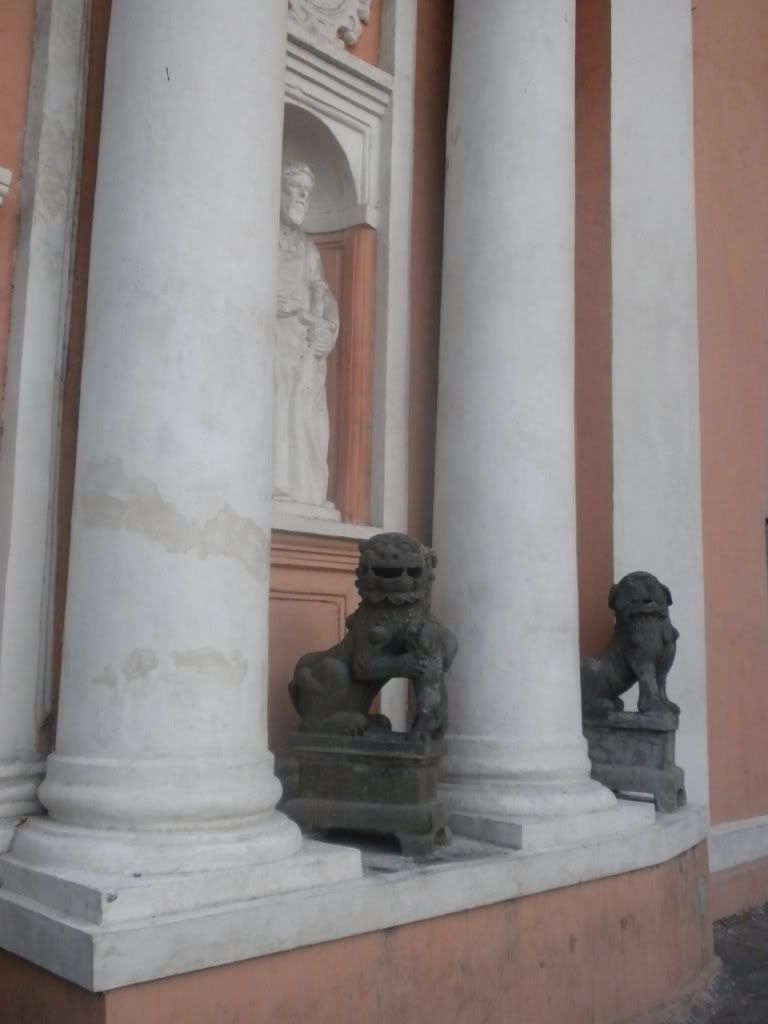
We wandered around the Church for a short while before being called to order by the Church bell. We returned to the hall where Carlos had set up American flags, ready to tell us about the American’s time in the Philippines. The Spanish-American War of 1898 resulted in Spain ‘selling’ the Philippines to the Americans for $20 million. This sale resulted in dramatic growth for the city; and identity confusion for its people. English books had children reading about Santa Claus, apple pie, and snow! Hollywood culture also arrived. But the switch from Spanish to English language had begun. Carlos showed us images of a 30-year change in Manila: from a basic sleepy town to a thriving city of action! The change evident in the photographs was quite awesome for just a 30-year period. Looked like 300 years!
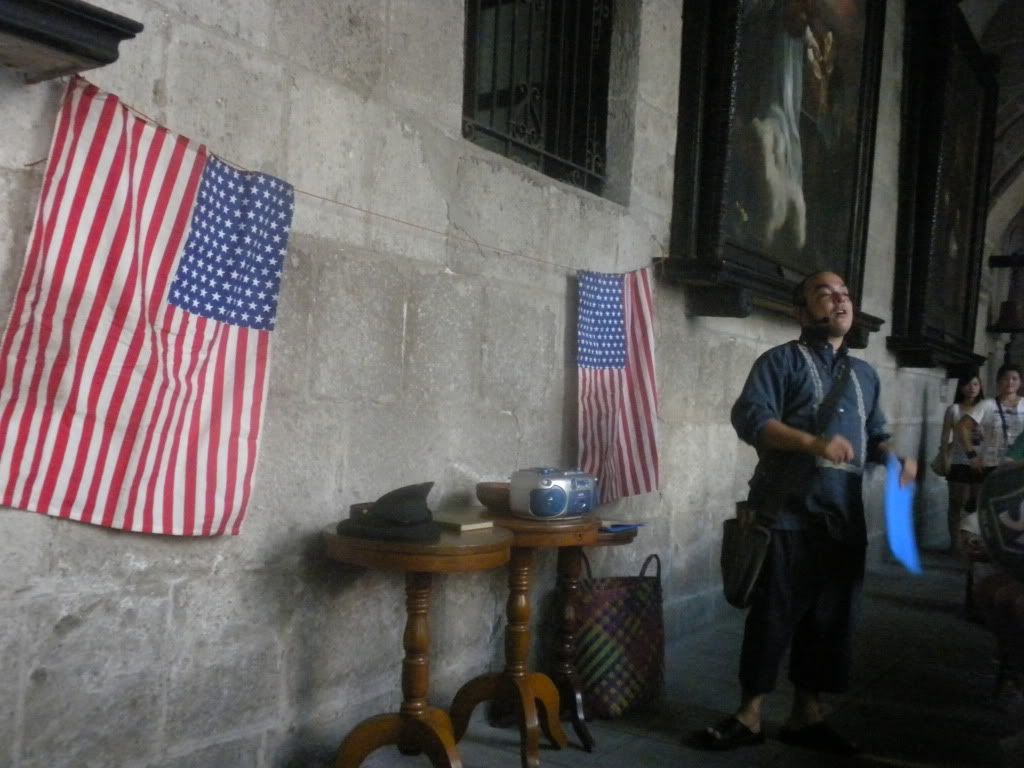
Anyways, Carlos donned his General McArthur cap and pipe and called us to follow him to a crypt down the hall. We sat on the floor amidst old plaques which proclaimed the deaths of people from the 1940’s. It was explained that Manila was bombed by the Americans during WWII because the Japanese had occupied it for 3 years. Between the Japanese massacres of Filipinos and the American bombings more than 100,000 people were killed. The city of Intramuros was almost totally destroyed. It became a dead city where thousands of bodies had to be literally bulldozed off the streets. After the Philippines came back to life, Intramuros began to be restored and honored as the part of Filipino history it once was.
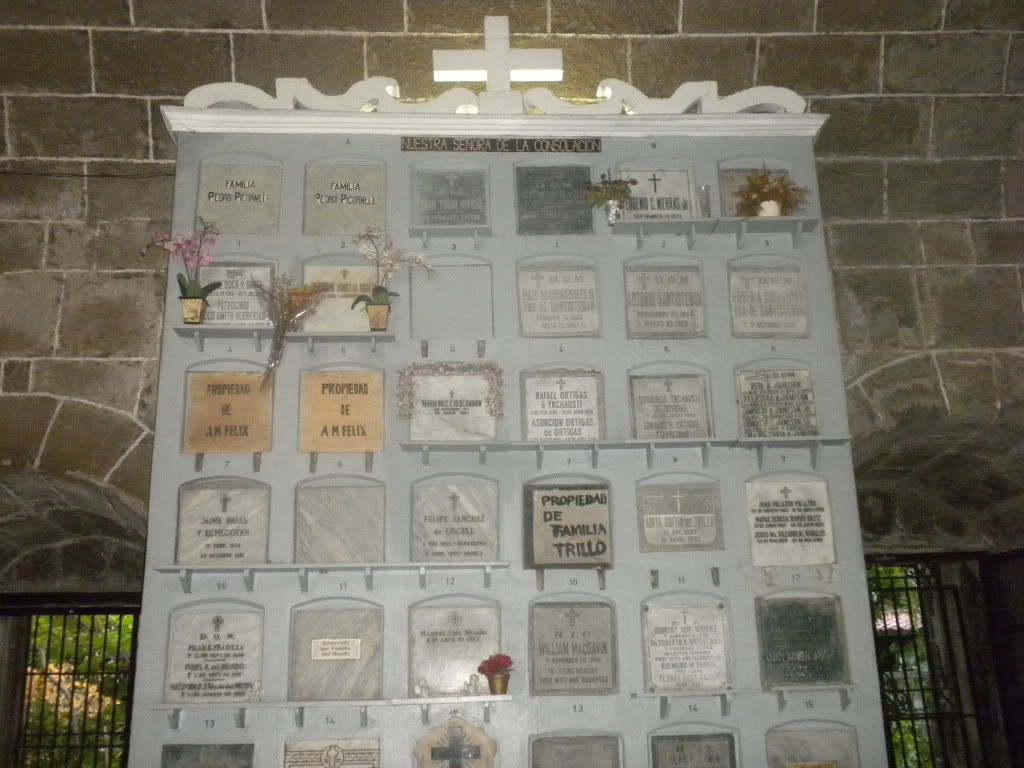
Carlos then took us outside to draw a great comparison of this ‘something simple, decorated to death’ concept: the jeepney. In reality the jeepney is an extremely basic car. Some of them we’ve seen on the streets are barely held together by any metal at all – the sheets folded over their frame look very rudimentary. HOWEVER, jeepneys look amazing!! Totally pimped. The amount of colorful, fascinating decoration thrown on them by excess-craving Filipinos makes them special. Graphitic images of comic book characters, stylized names and phrasing praising Christian imagery, all the bells and whistles you can imagine. Our next stop was across the street at the Plaza San Luis where Carlos would further demonstrate this concept to us with a ‘halo-halo.’
The Plaza San Luis Complex had been destroyed by the WWII bombings. But it has been restored by the First Lady of the Philippines. Again, the same Filipino cultural philosophy had been applied in the creation of the Plaza: very basic buildings once you take away the fancy decorations. The fact that the Filipinos are not very original, well, makes them in essence quite original, doesn’t it? They just can’t get enough of a good thing. Even in the familial identity was this evident. Carlos showed us a picture of a clearly “of Chinese ancestry” family. They were dressed in Spanish-style clothing, calling themselves ‘a Catholic Spanish family’, yet they spoke English and practiced trade in Indian and Middle Eastern goods! And they were by blood Chinese! All of this helps to make them truly Filipino. Finally we got our halo-halo aka “mix-mix” desserts. It was exactly as it sounds: ice, cream, jelly pieces, beans, ube, and other sweet items mixed together. Have it all!
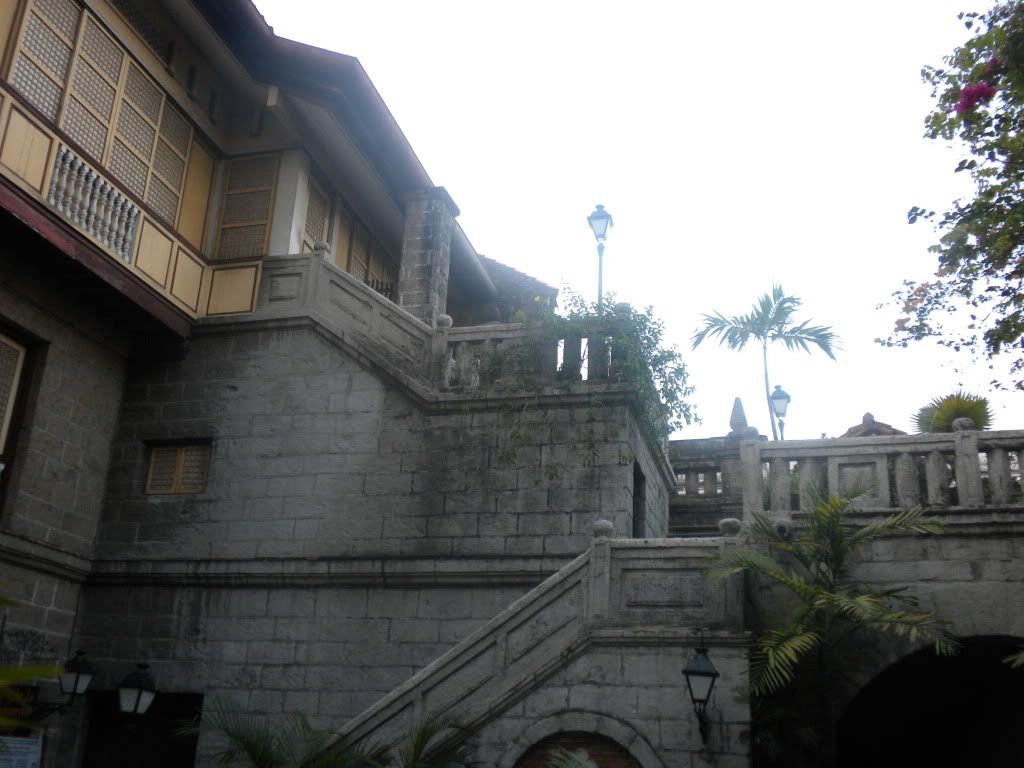
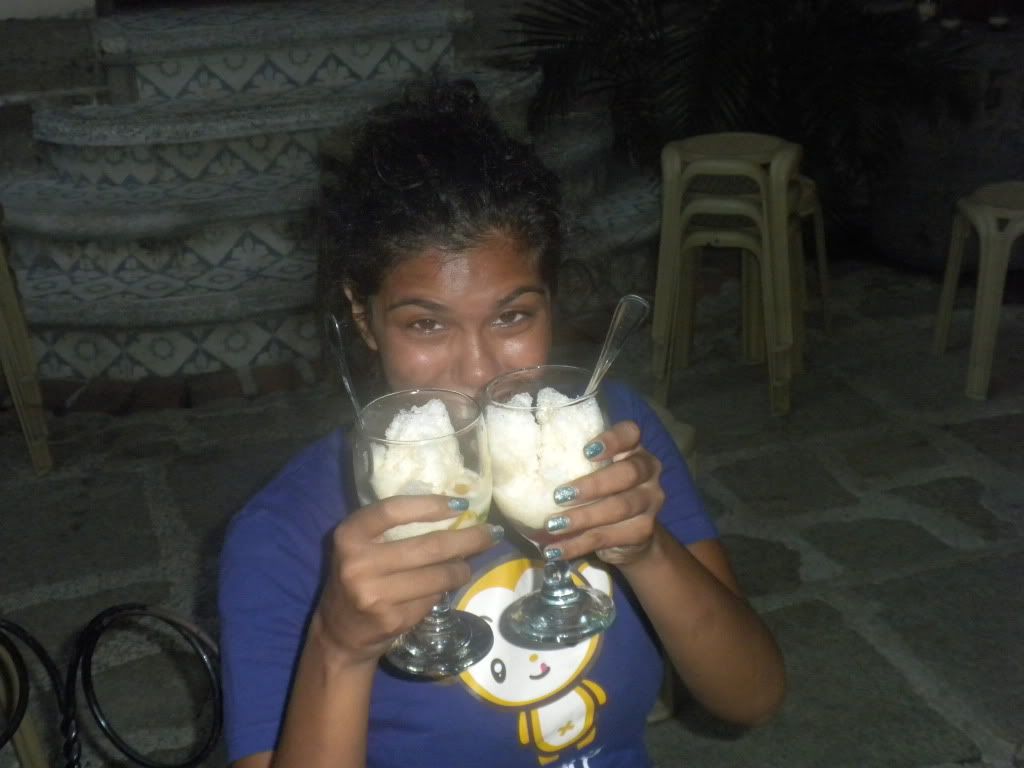
After the tour Henk and I went back to the hostel where we discovered the Formula 1 of Monaco was showing on the TV in the lounge room upstairs. We researched flights for the upcoming days to the other islands around the Philippines (these flights are pretty cheap) while watching the race. For dinner on the 16th I ordered a ‘Pop Pizza’ from Pizza Hut for dinner. This pizza has a ‘cheese pizza’ center, but is surrounded by mini hot dogs slathered in ketchup and mayonnaise (you can choose the topping) each encased in a bread crust bun, almost like those mini-hotdogs they have on little platters at parties. The pizza is served with a nacho cheese dip which the hotdogs can be pulled off and ‘dunked’ into. Probably one of the unhealthiest things I’ve consumed on this entire trip! Yikes! But SO yum.
Francesca
Anyways, Henk and I took a metered cab to Friendly’s Guesthouse, where we planned to stay a few days to plan our time in the country and get our bearings. We booked into a small double room and proceeded to whip out the Lonely Planet, various magazines and brochures, and with the wealth of information on the internet, began to plan our trip. We ordered in food (pizza for myself, spaghetti for Henk) and worked on our schedule for the upcoming weeks. However, we quickly ran into trouble.
There are over 7,000 islands which comprise the Philippines … specifically 7,107 of them. Obviously this leads to a lot of confusion when planning where to go and how long to stay. I had a particularly difficult time learning the ‘map’ of the Philippines; where exactly the different cities were, the various names and where the ‘to do’ activities were within said locations. Thankfully, Henk thought to ask Benji, the owner of Friendly’s, for some advice on where to spend our time. He drew out a little timeline for us, rattling off names of cities and helpful tips on which to visit and in what order. BIG help to get us started. I finally finished making my personal ‘self help’ guide of the important Lonely Planet information and Henk found details of tours online. More confident about what our plan was, we took the next couple days to relax in the many malls of Manila.
The morning of the 13th, we headed around the corner to Robinson’s Mall, and were in awe almost immediately upon entering the mall. There were food stalls EVERYWHERE! Filipinos love to eat, probably even more than Americans, and we saw row after row of restaurants and snack stalls. I couldn’t even see the shops through the food! Everything from New Orleans gumbo complete with waiters and waitresses wearing colorful Mardi Gras hats to Middle Eastern dishes, classic American, Thai, Japanese, Italian, Chinese, even Mongolian! My favorite was a place that called itself ‘The House That Fried Chicken Built!’ The snacks and fast food were even more impressive: mini empanadas, make-your-own pitas, doughnuts and cakes galore, and eateries dedicated to dish combinations such as ‘Chicken and Waffles.’
The last of these delicacies is what we feasted on that afternoon, well I did, while Henk ordered a large salad complete with waffle croutons and ‘won’ two free fruit cups for his health efforts. I don’t know if it is a wise concept to reward healthy eating with more food, but Henk was happy! We went over some of our trip ideas while eating, and then put them aside for some rest time watching Iron Man 2 in the movie theater we found on an upper floor. I think it has been half a year since we’ve been out to the movies! We also decided to send another box home to Florida via DHL with 10 kg of stuff… it’s been a difficult choice to send things home; Henk does the carrying of our large bags and it becomes tiresome to lug around so much, but it costs a bundle to send even just a little bit of stuff home. And there is always the risk of losing something…

The 14th was spent planning our trip, packing up our box, and getting a manicure/pedicure for myself. (It had been ages since I last had one!) We ate at the ‘House That Fried Chicken Built’ which is actually called Max’s, ordering chicken for me and an asparagus/tofu dish for Henk. Since we realized after packing our box that we still had an extra 2 kg of weight, we rushed back to the hostel and grabbed a ton more stuff to try and fit in. We did it… exactly 10 kg of weight! We paid for it, and set off.
We had to go to bed early that night because we had to get up to meet a group at 4:00 AM for a tour to the 2010 Pahiyas Festival in Lucban. Initially we were told Lucban from Manila was about a 2.5-3 hour drive. WOW, was that wrong! Anyways, we met our group at the buses outside of the Peninsula Hotel and were assigned to Bus #2. We settled in for the long drive, watching a string of movies along the way. However, after watching all 3 of the Resident Evil trilogy plus two other movies we realized we had been driving for QUITE a long time. Yes, the traffic was horrible, but we had spent the first hour of our ‘tour’ sitting in the parking lot waiting for additional people to arrive.
Thus we left an hour later, hitting the horrible morning rush. Henk and I grabbed breakfast at Jollibee – which was not too fantastic – and continued sitting in the bus. It wasn’t until 12:00 PM that we made it to the festival. This doesn’t seem too late, but mind you we were 4 hours behind schedule and had missed one of the churches/shrines we were supposed to see. At first we thought the lateness might be something the locals were used to, but when we sat down to eat we heard the complaints start! We walked until reaching a large buffet where we tried to sift through the gruesome food there to find something edible. Or decently edible. It all looked pretty disgusting to me… every single time we encounter a buffet on this trip, I end up sick. I stuck with the dessert table, while Henk chanced the buffet only to later complain through the afternoon about an upset stomach.
It wasn’t until around 2:00 PM that we actually got to look at the festival. It was jam-packed with people and difficult to walk through the streets but we managed. We were handed a piece of paper that explained a bit more about the festival we were witnessing, the important parts I’ll copy here:
“The Lucban San Isidro Pahiyas Festival is one of the most colorful in the Philippines… the main attraction are the houses decorated with ‘kiping,’ a rice-wafer molded like a leaf and hung in chandeliers and other creations, shapes and sizes. The festival is a form of thanksgiving to God (originally a nature/animist festival, now Christianized) through San Isidro, the patron saint of farmers for the bountiful harvest, thus most of the houses are adorned with fruit and vegetables as an offering.”

The houses looked really cool: covered in kiping and other natural decorations such as vegetables, dried and painted coconut shells, fruit, leaves, rice stalks, grasses – some even had ‘paintings’ made out of colorful seeds/beans or what appeared to be crushed kiping. Others had make-shift animals such as birds crafted out of hanging vegetables, or pigs created from natural fibers. Some buildings were decorated with colorful organic hats and/or fans. Henk and I noticed that many of the houses had numbered ‘tags’ on them. The houses were going to be judged on their decorations! Fun… later we walked around viewing the winners. We were blow away by the top two winners; try and figure out which two they are! (If you zoom on some of the pictures, their ‘winner’s place’ banner might show.)
We also witnessed the festival parade while in Lucban. While there was plenty of kiping-covered floats advertising corporations or local sponsors (even a few people with product names painted directly on their bodies) the parade was still interesting to watch for the unique ‘fashion show.’ Known as “parikitan,” this parade is a showcase of costumes made of organic materials. The colorful clothing resemble the house decorations, but more refined. Following the outfits were a few water buffalo, painted for the celebration.












At one point Henk and I passed a ‘make-shift pinyata’ or so I’ll call it, because it was a bamboo basket with tons of bagged and canned food hanging off of it. Snacks! Henk used his long arms to reach above everyone and grab some of the good stuff! We later passed off the packaged noodles to some locals. I also tried the fried bananas on a stick, and a little cup full of fried kiping! You can actually eat the decorations on the houses! All you have to do is toss the kiping rice-wafer into a deep-frier and sprinkle a bit of sugar over it. Didn’t taste like much, pretty much only tasted like sugar, but cool to look at.










While debating if we should ditch our tour group, we ducked into the Parish of St. Louis Bishop to try and escape the blazing sun. We admired the large dolls representing various Christian saints and figures, then following the music outside to witness a bunch of kids doing a colorful dance. Upbeat music and cheerleading moves made it hard for us to believe this dance was anything historical, but it was interesting to watch regardless. It was however another church that caught our eye as we made our final walk through the festival streets. The Lucban Catholic Church that won the decoration contest. According to our paper guide, this church is a “…blending of Baroque and Castilian architecture, measuring 180 feet long and 38 feet wide.” It is apparently dedicated to the Virgin Mary.
















That evening we caught a tricycle to a jeepney where we were driven to a bus which would take us to Quezon City. Then, we had to get in a taxi to get back to Manila where our hostel was. Well past midnight we finally arrived at Friendly's. What a horrible trip back that was! We crashed when we got in — we wanted to rest up for the next afternoon. We had a tour to attend!
Henk and I wanted to sleep in on the 16th, but we were going to try and do some more couch surfing to meet a few local people! However, the realization the day before about the traffic and travel time around Manila turned us off to the idea of having to venture outside of Manila to stay with someone and catching a taxi back into the city every day to tour around. We were supposed to house with a friendly girl and her mother, but feared traveling back and forth would seriously cut our exploration time. We ended up just switching to a larger room in the same hostel and booking in for a couple more nights.
I have to tell you all about the fantastic place we went to for lunch that afternoon! It was called Café Adriatico and we found it recommended in our map of Manila and the Lonely Planet. WOW, were they right to point us in that direction! We couldn’t decide what sounded better, so we ordered a little feast: warm minestrone soup, delicious bruschetta, some pesto-sauced spaghetti, and an out-of-this-world triple mushroom and cheese mini sandwich on soft ciabatta bread. Amazing!! One of the best meals I’ve ever had was that little mushroom delicacy. It even came with a balsamic vinegar side salad of cucumbers and tomatoes that blew me away – and I am not a fan of vegetables. To top it all off, the prices weren’t bad either. We plan on having a slice of their baked-in-house chocolate cake when we get back to Manila.
Just before 4:00 PM we arrived at Fort Santiago in the walled city of Intramuros. We were there for the infamous tour by Carlos Celderan called, ‘If These Walls Could Talk: the Deluxe Version.’ He started by singing the National Anthem, following with a brief history of the Philippines islands. He explained to us that the islands were on the volcanic ‘ring of fire’ but that this was not the sole source of the national volatility. Previous to the Spanish, the Filipinos built their houses and structures of bamboo; they had no natural known source of stone. Where the Fort Santiago now stands, there was originally a Fort of Rajah Soliman, the native Tagalog chieftain, and the area was a center for trade. When the Spanish came, they began using volcanic ash to create adobe thus rebuilding the Fort and changing the architecture of the Philippines forever.




Carlos explained that the national language of the Philippines, Tagalog, which combines Spanish, English, Malayu and older Eastern words to form a mix, understood by the people today. As we were walking in the Fort, he added as a sidenote for us to notice the relief carving above us on the gate arch of a Saint James killing Muslims (Moors) on the Fort. Carlos was adamant about viewing Manila in a ‘different light’ than usually seen; Manila is thought of as an unattractive city when in reality it has a dramatic tale and a striking history.

Starting from the colonialism brought by the Spanish (including theocratic rule in the city by the friars), followed by the colonialism by the Americans (and eventual destruction of Manila), and ending with the re-creation of the Filipino people he told Manila’s story. The Spanish, led by Martin de Goiti and later Miguel Lopez de Legazpi conquered the native city and founded the city of Manila where it stood. Walls and a moat were constructed around the city, closing it off to invasion by the Chinese and Japanese pirates – even the Dutch tried to attack the city, and the British successfully held it for 2 years.
Carlos pointed to a statue of Rizal on the lawn of the Fort, the country’s national hero. Rizal wrote 2 books criticizing the theocratic rule his country was under during Spain’s time there. He was eventually shot in the head for ‘inciting revolution in the people.’ (More about him later, as we visit a great wax museum on his life!) We were then all loaded onto carriages pulled by horses for a ride over to the Church of San Agustin, Manila’s only standing Church post-WWII bombings. While you might think initially ‘How could a Church, a Spanish-Catholic concept brought to the Philippines, be a uniquely Filipino example of architecture?’


Carlos explained that Filipinos have always absorbed various ‘new’ cultures into their own. They love excess to the extreme. For example, the Church itself once you strip away the decoration is just a simple building: the carvings are all painted on (yes, look at the detail picture!) and the columns are not a structural part of the building – just for pure decoration. There are even Chinese lions out front; that was clearly not a Filipino invention! But using a Chinese lion on a Catholic Church? Pure Filipino.



We wandered around the Church for a short while before being called to order by the Church bell. We returned to the hall where Carlos had set up American flags, ready to tell us about the American’s time in the Philippines. The Spanish-American War of 1898 resulted in Spain ‘selling’ the Philippines to the Americans for $20 million. This sale resulted in dramatic growth for the city; and identity confusion for its people. English books had children reading about Santa Claus, apple pie, and snow! Hollywood culture also arrived. But the switch from Spanish to English language had begun. Carlos showed us images of a 30-year change in Manila: from a basic sleepy town to a thriving city of action! The change evident in the photographs was quite awesome for just a 30-year period. Looked like 300 years!

Anyways, Carlos donned his General McArthur cap and pipe and called us to follow him to a crypt down the hall. We sat on the floor amidst old plaques which proclaimed the deaths of people from the 1940’s. It was explained that Manila was bombed by the Americans during WWII because the Japanese had occupied it for 3 years. Between the Japanese massacres of Filipinos and the American bombings more than 100,000 people were killed. The city of Intramuros was almost totally destroyed. It became a dead city where thousands of bodies had to be literally bulldozed off the streets. After the Philippines came back to life, Intramuros began to be restored and honored as the part of Filipino history it once was.

Carlos then took us outside to draw a great comparison of this ‘something simple, decorated to death’ concept: the jeepney. In reality the jeepney is an extremely basic car. Some of them we’ve seen on the streets are barely held together by any metal at all – the sheets folded over their frame look very rudimentary. HOWEVER, jeepneys look amazing!! Totally pimped. The amount of colorful, fascinating decoration thrown on them by excess-craving Filipinos makes them special. Graphitic images of comic book characters, stylized names and phrasing praising Christian imagery, all the bells and whistles you can imagine. Our next stop was across the street at the Plaza San Luis where Carlos would further demonstrate this concept to us with a ‘halo-halo.’
The Plaza San Luis Complex had been destroyed by the WWII bombings. But it has been restored by the First Lady of the Philippines. Again, the same Filipino cultural philosophy had been applied in the creation of the Plaza: very basic buildings once you take away the fancy decorations. The fact that the Filipinos are not very original, well, makes them in essence quite original, doesn’t it? They just can’t get enough of a good thing. Even in the familial identity was this evident. Carlos showed us a picture of a clearly “of Chinese ancestry” family. They were dressed in Spanish-style clothing, calling themselves ‘a Catholic Spanish family’, yet they spoke English and practiced trade in Indian and Middle Eastern goods! And they were by blood Chinese! All of this helps to make them truly Filipino. Finally we got our halo-halo aka “mix-mix” desserts. It was exactly as it sounds: ice, cream, jelly pieces, beans, ube, and other sweet items mixed together. Have it all!


After the tour Henk and I went back to the hostel where we discovered the Formula 1 of Monaco was showing on the TV in the lounge room upstairs. We researched flights for the upcoming days to the other islands around the Philippines (these flights are pretty cheap) while watching the race. For dinner on the 16th I ordered a ‘Pop Pizza’ from Pizza Hut for dinner. This pizza has a ‘cheese pizza’ center, but is surrounded by mini hot dogs slathered in ketchup and mayonnaise (you can choose the topping) each encased in a bread crust bun, almost like those mini-hotdogs they have on little platters at parties. The pizza is served with a nacho cheese dip which the hotdogs can be pulled off and ‘dunked’ into. Probably one of the unhealthiest things I’ve consumed on this entire trip! Yikes! But SO yum.
Francesca

3 Comments:
Mijn vakantie valt helemaal in het niet bij het lezen van jullie verhalen en kijken naar de foto,s.
Wat een reis,om nooit meer te vergeten toch? Ik berijp niet dat jullie zo slank blijven met al dat eten. Door al jullie verhalen,ben ik straks de wereld ook over geweest. Zo voelt het. Oma xxxx
Wat een cultuurshot en wat een pracht en praal en lieve fran wat pas je daar weer leuk tussen!!!
Gina
Max's chicken! Oh how I miss the Philippines! Did you guys try the Balut yet?
Post a Comment
<< Home